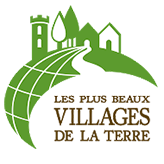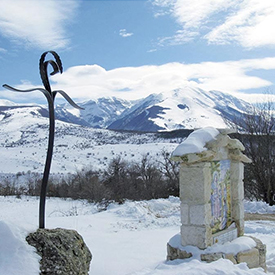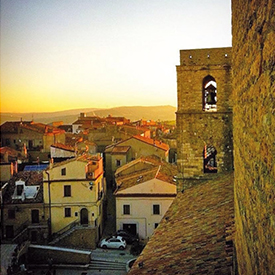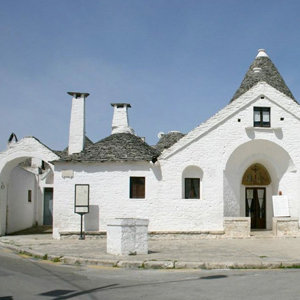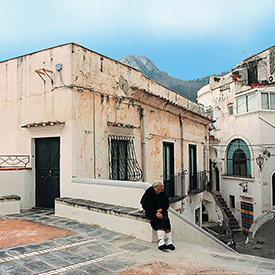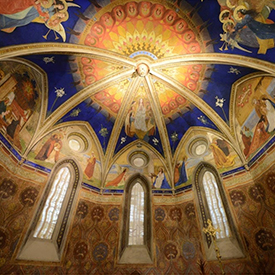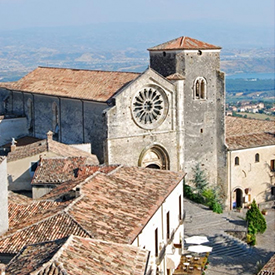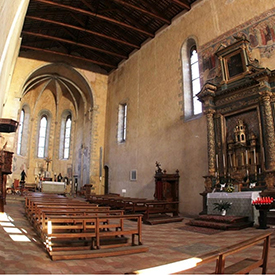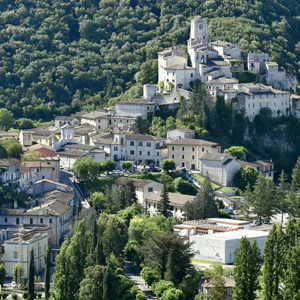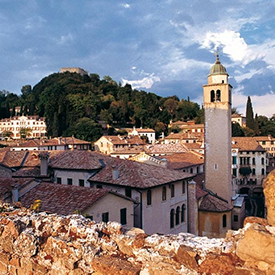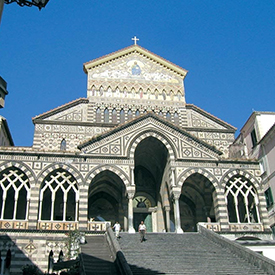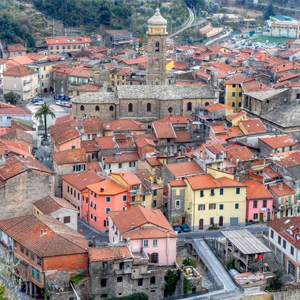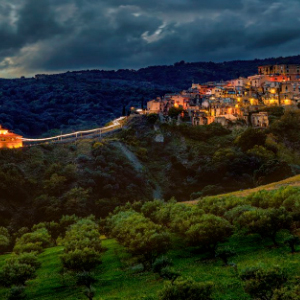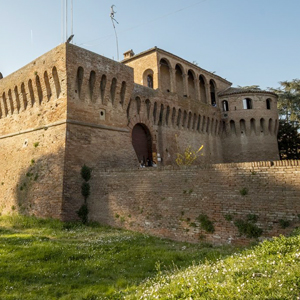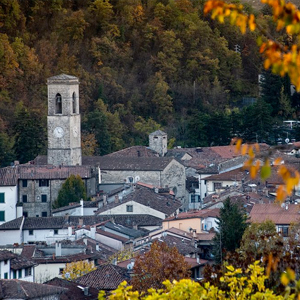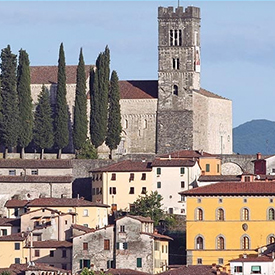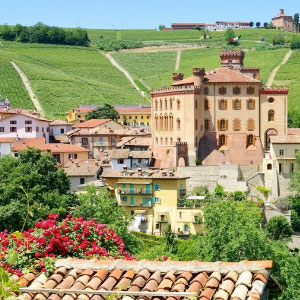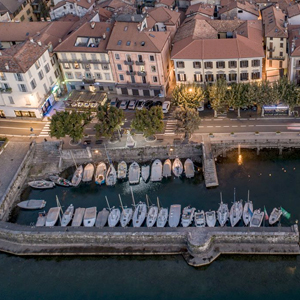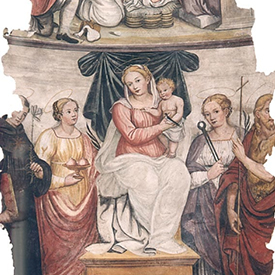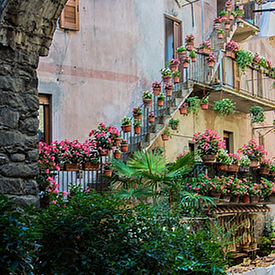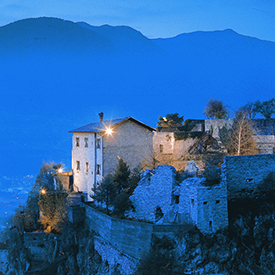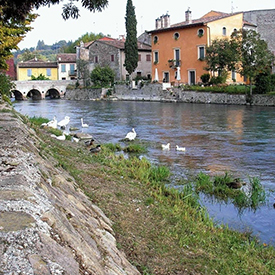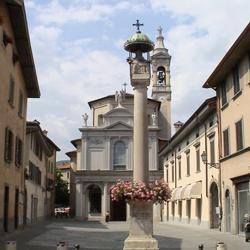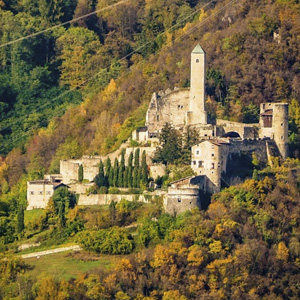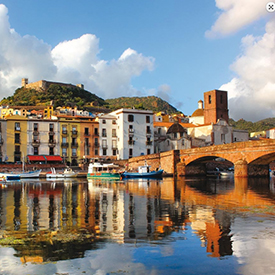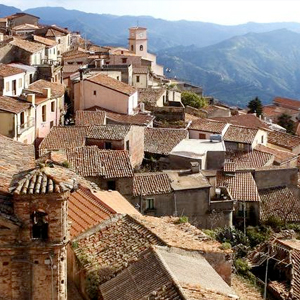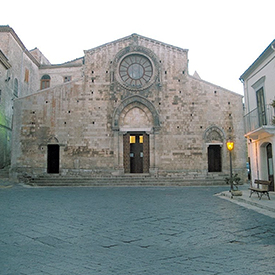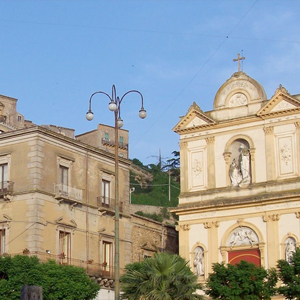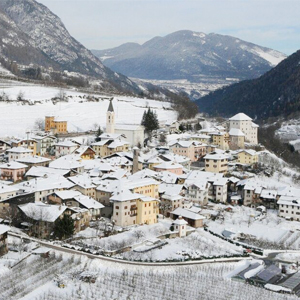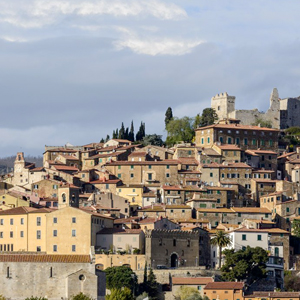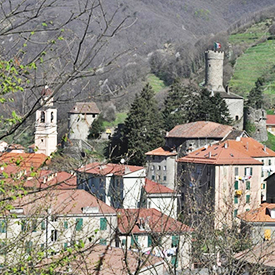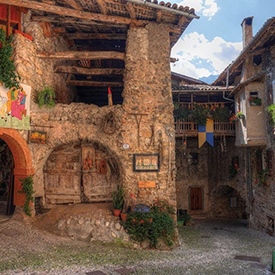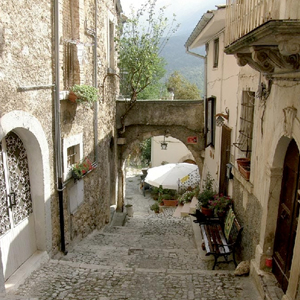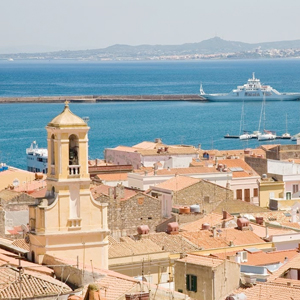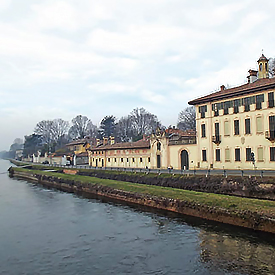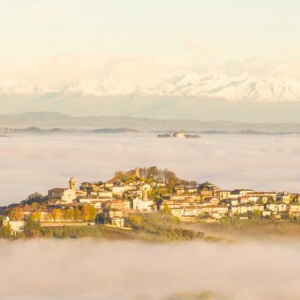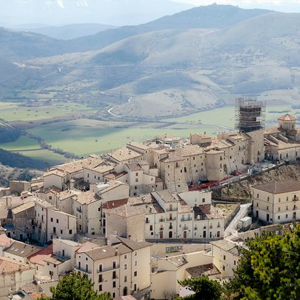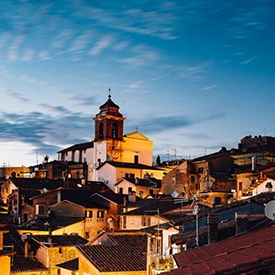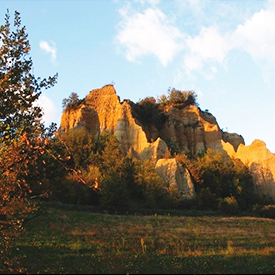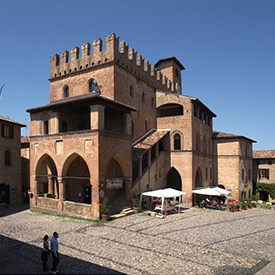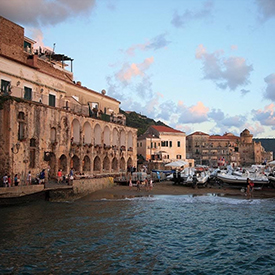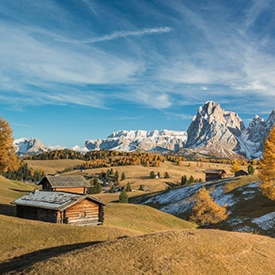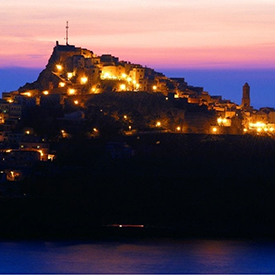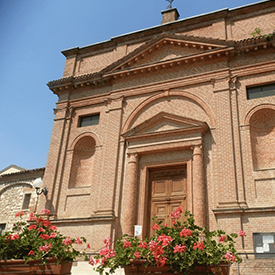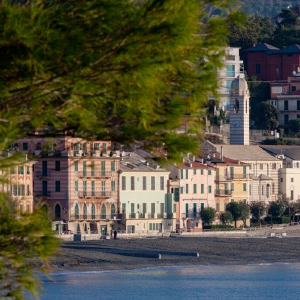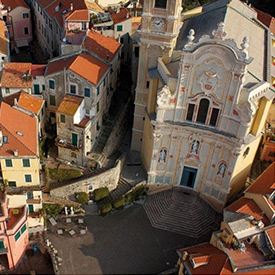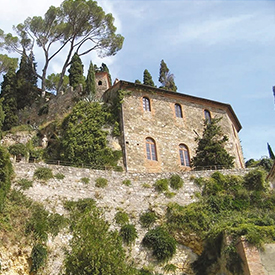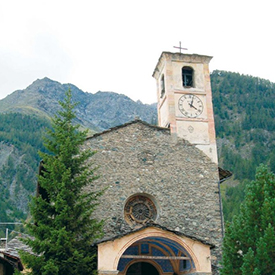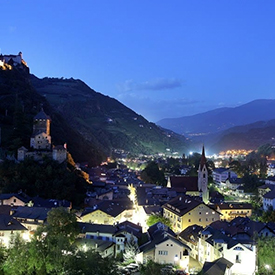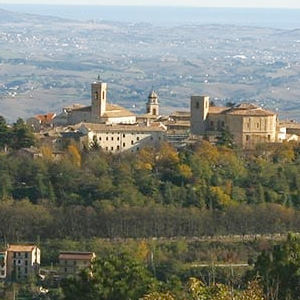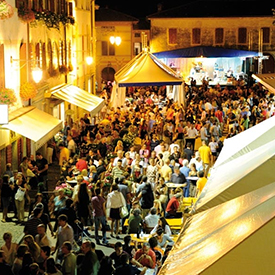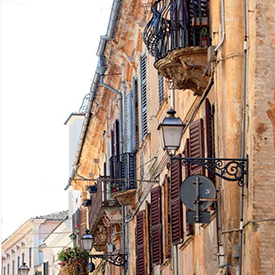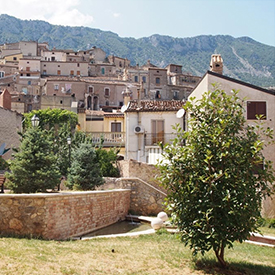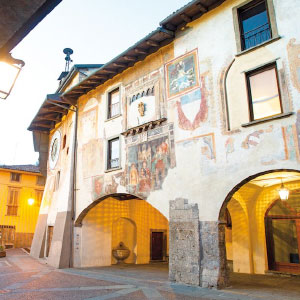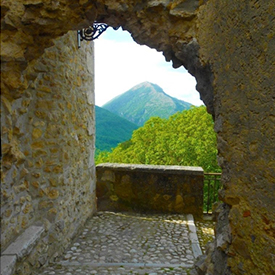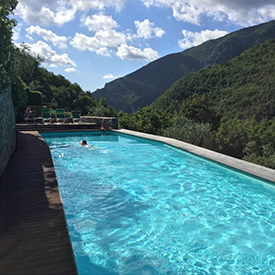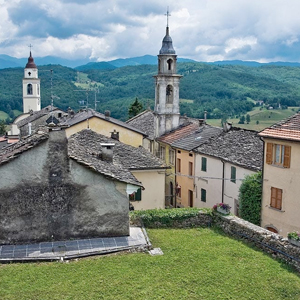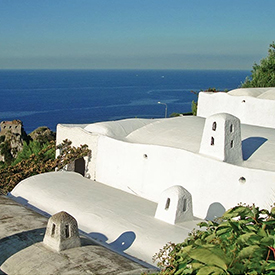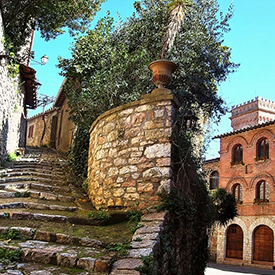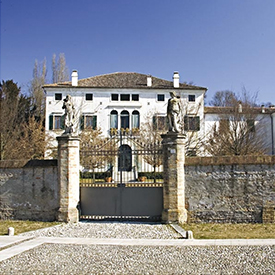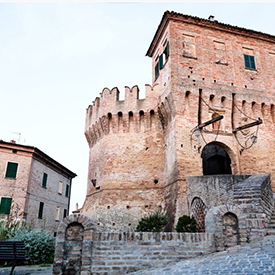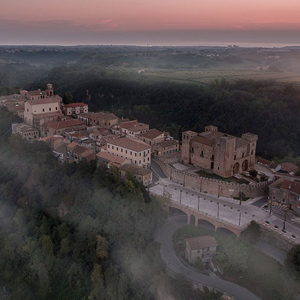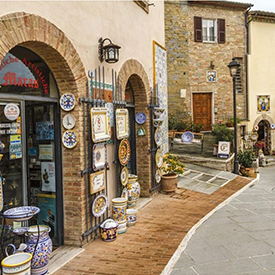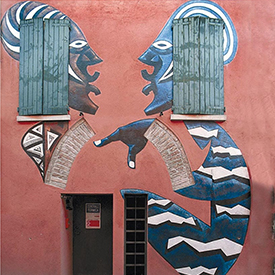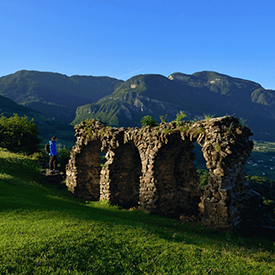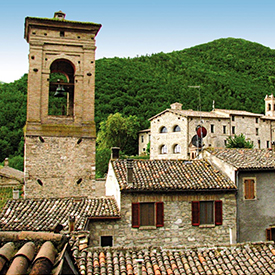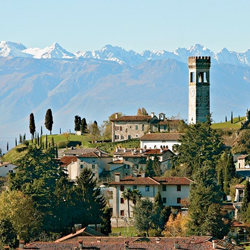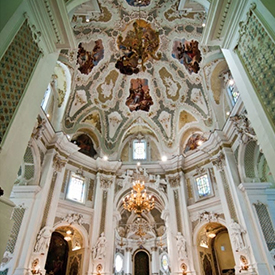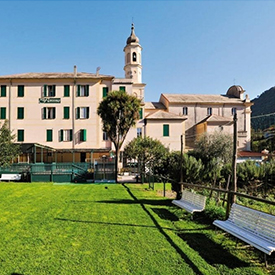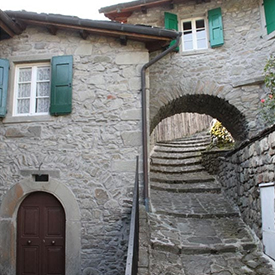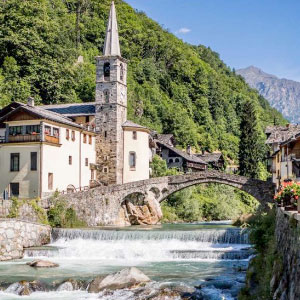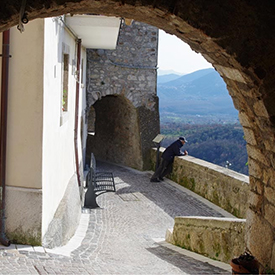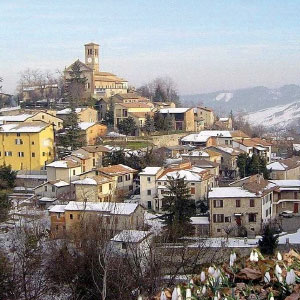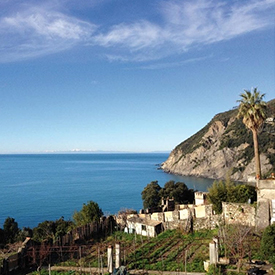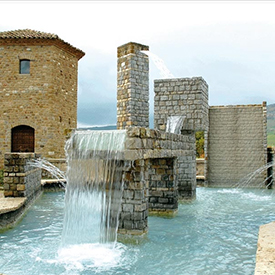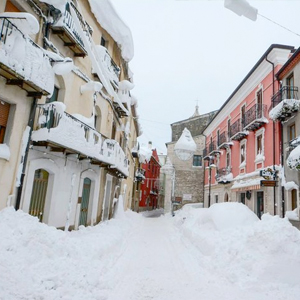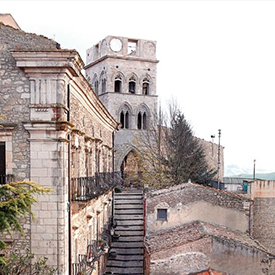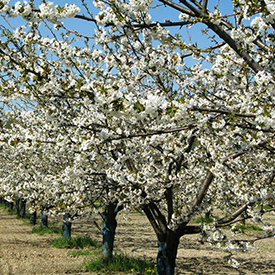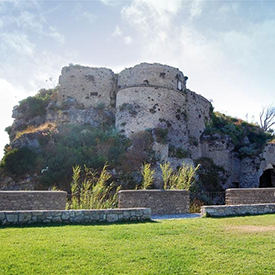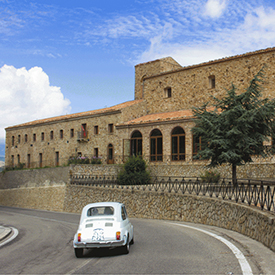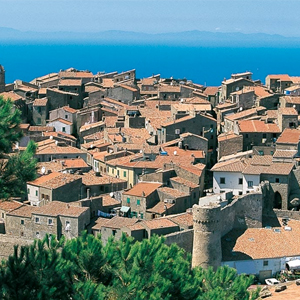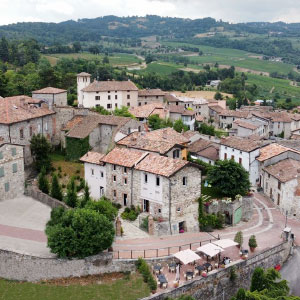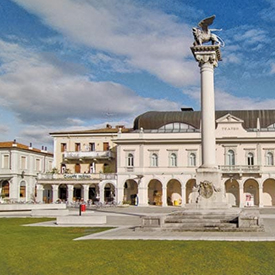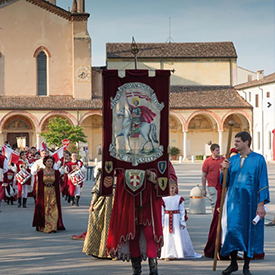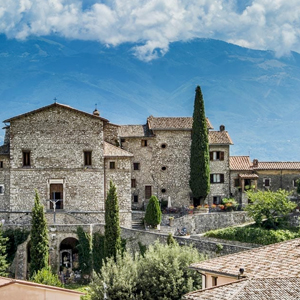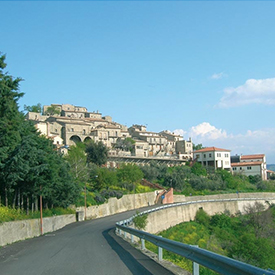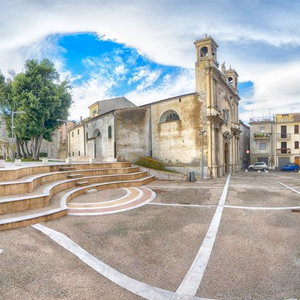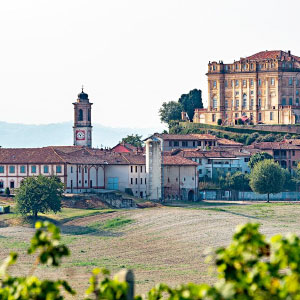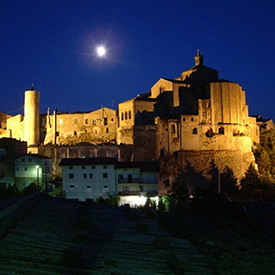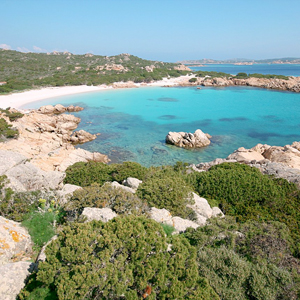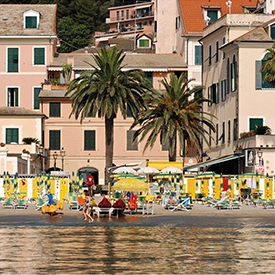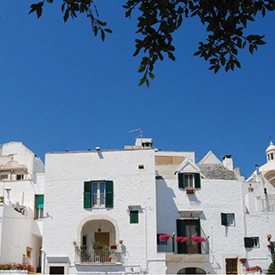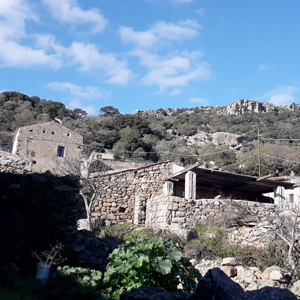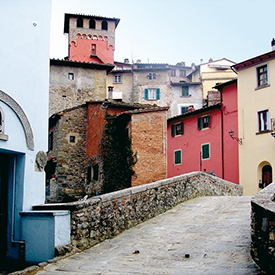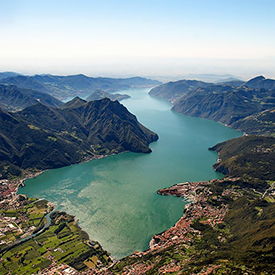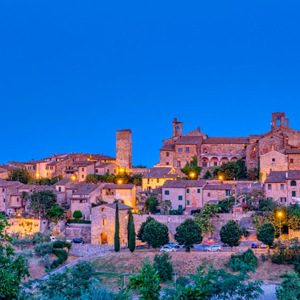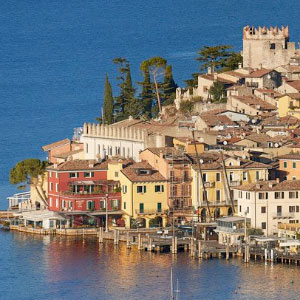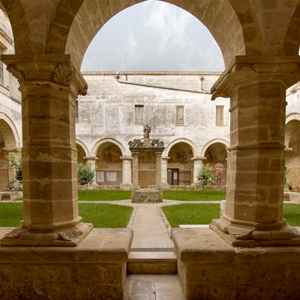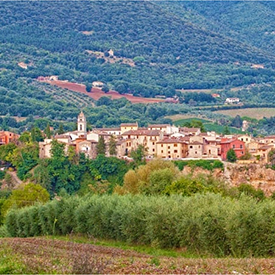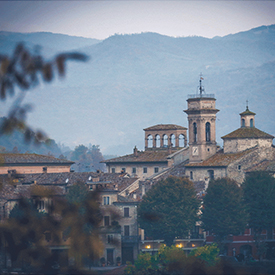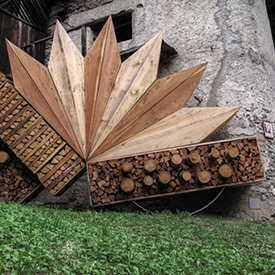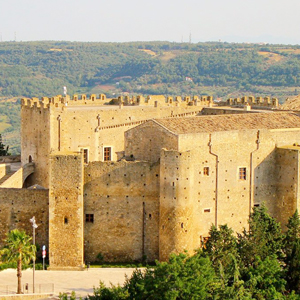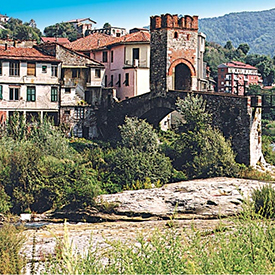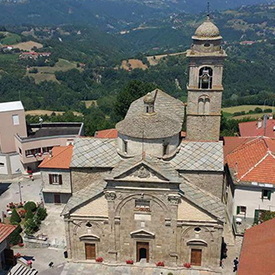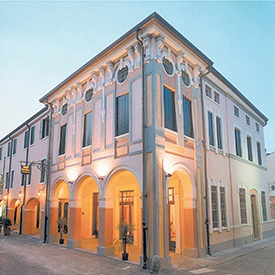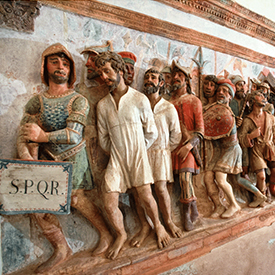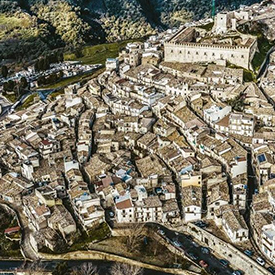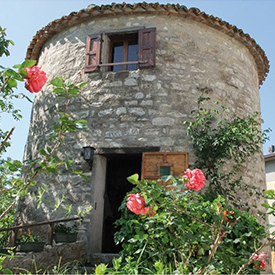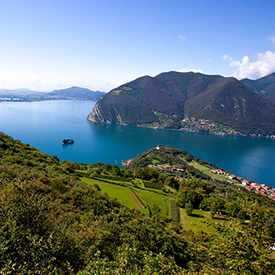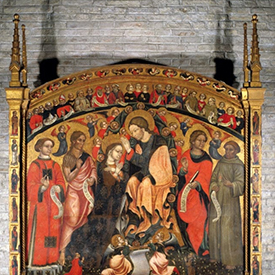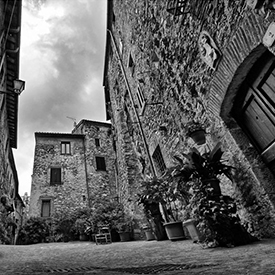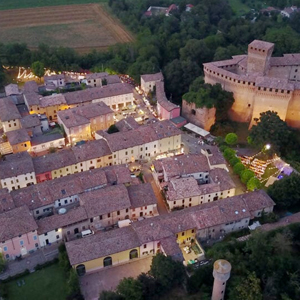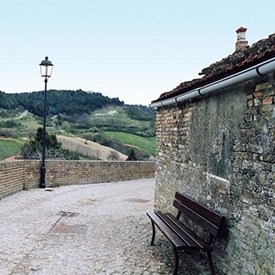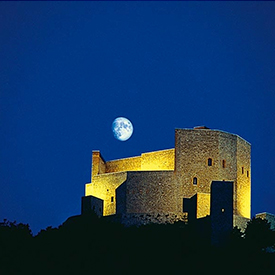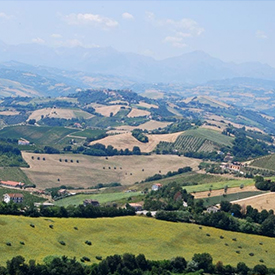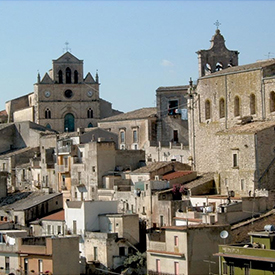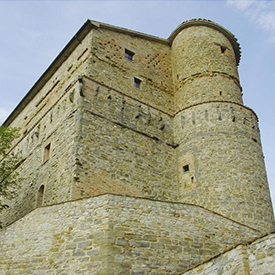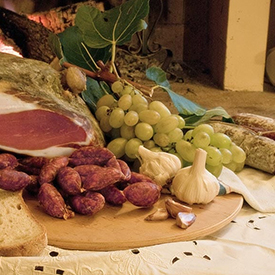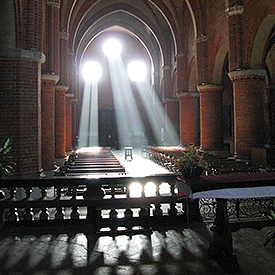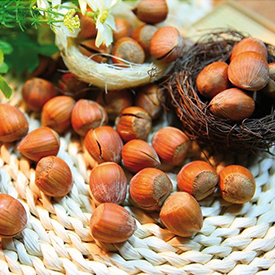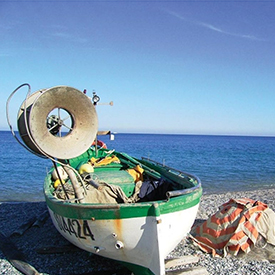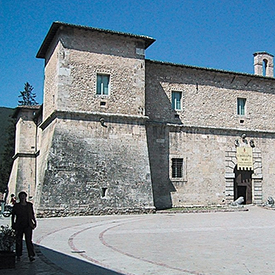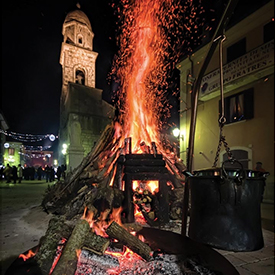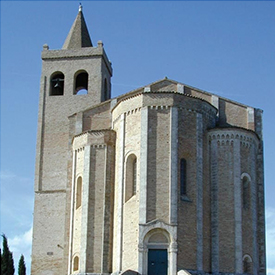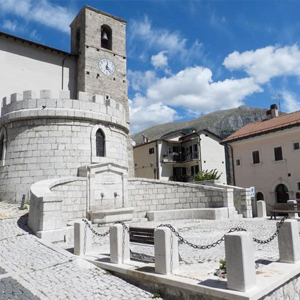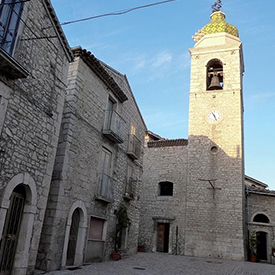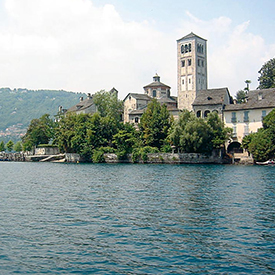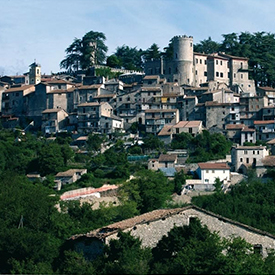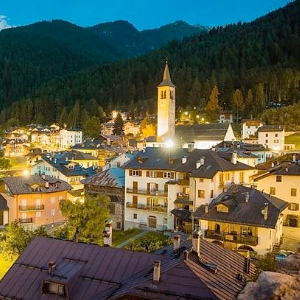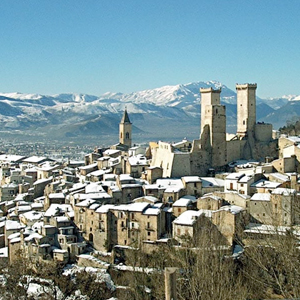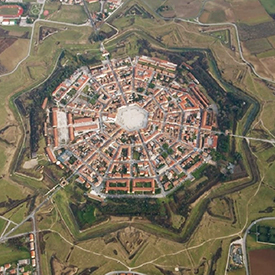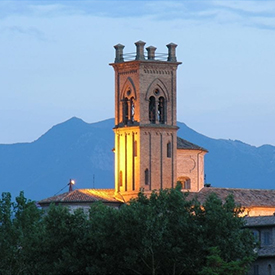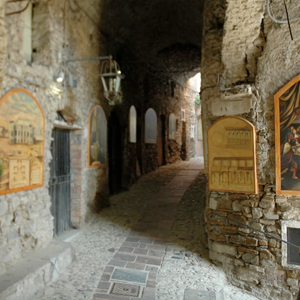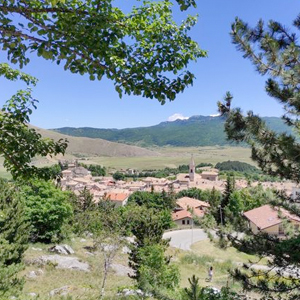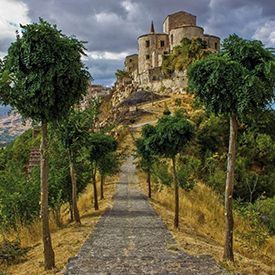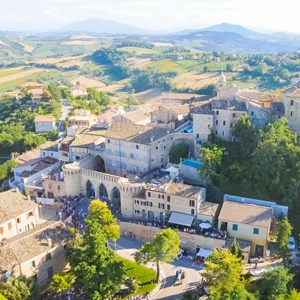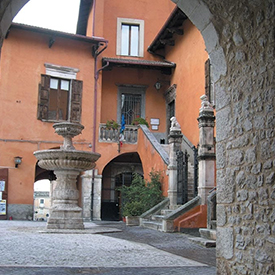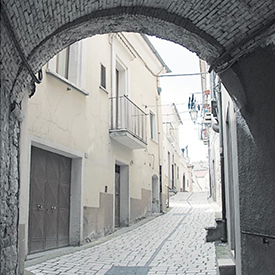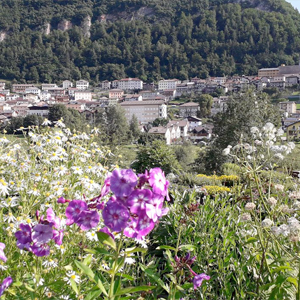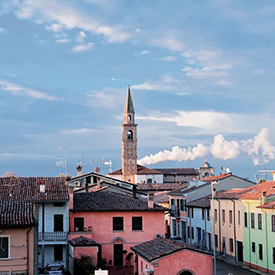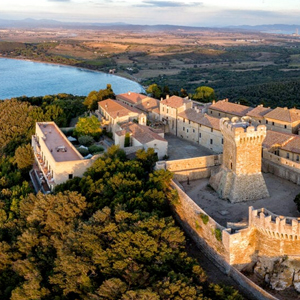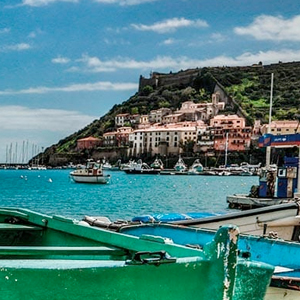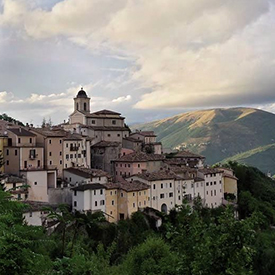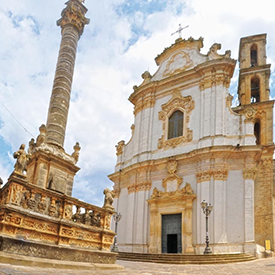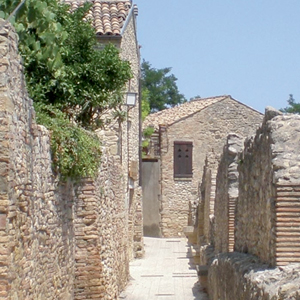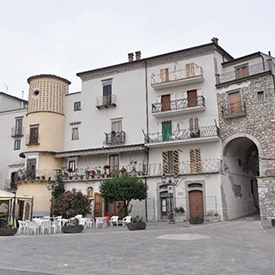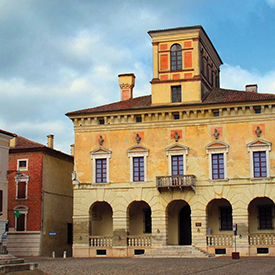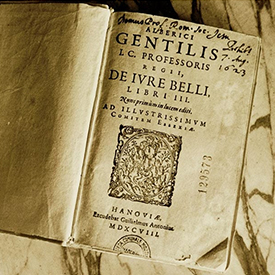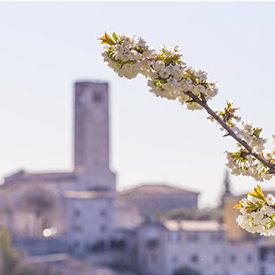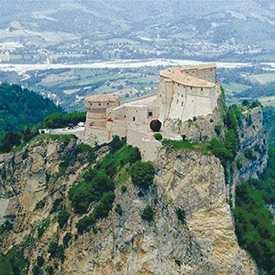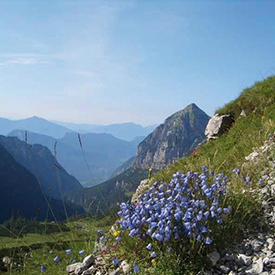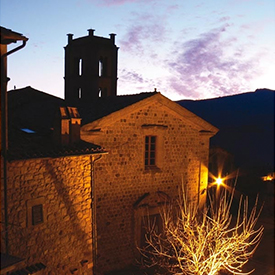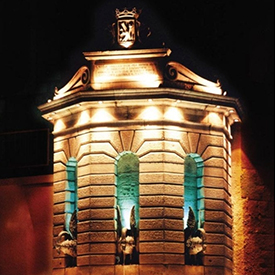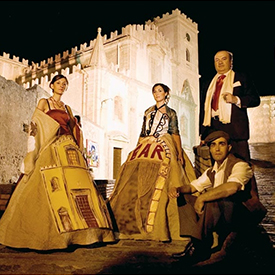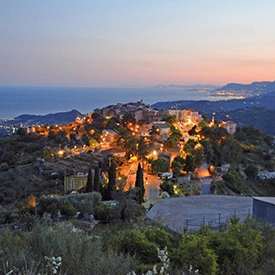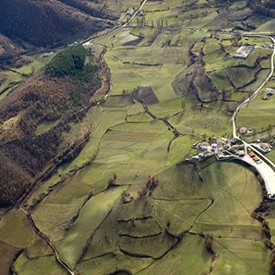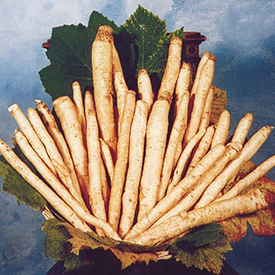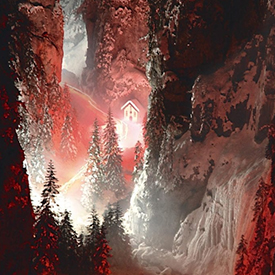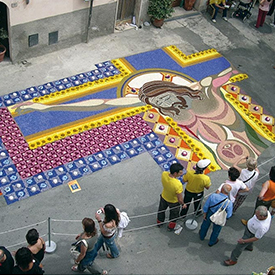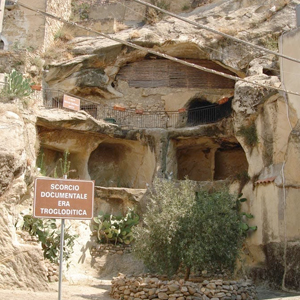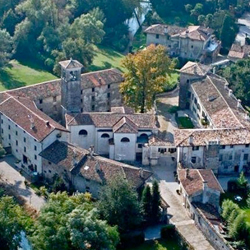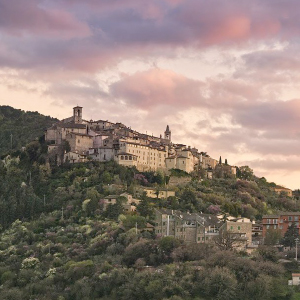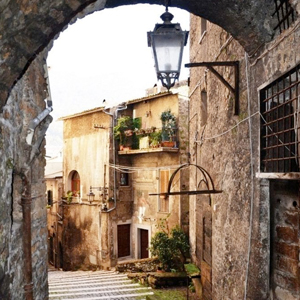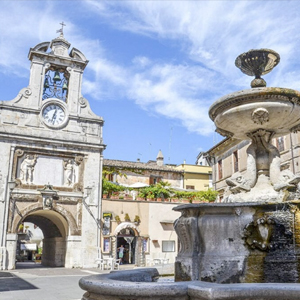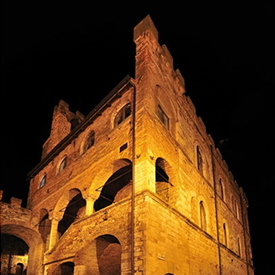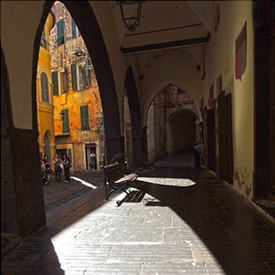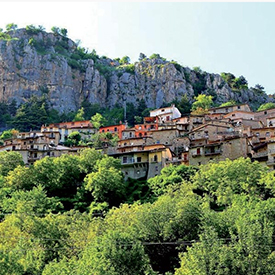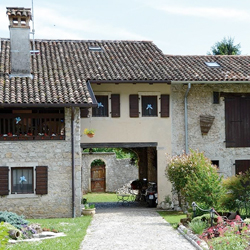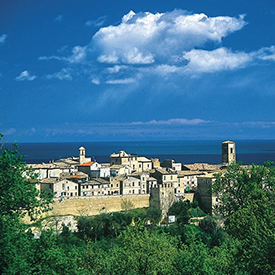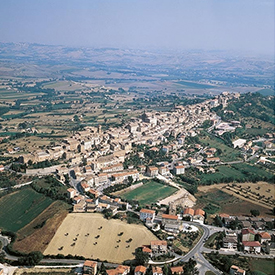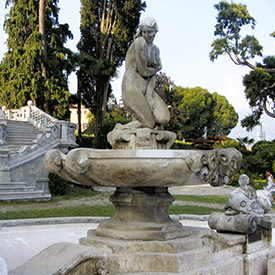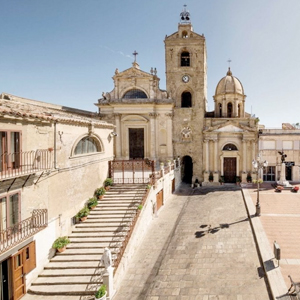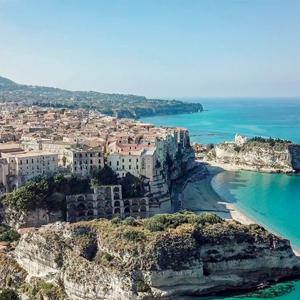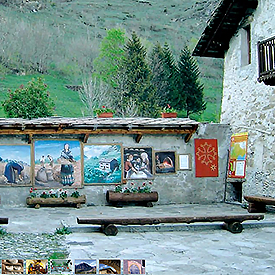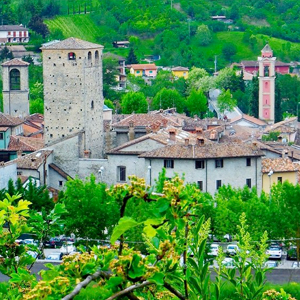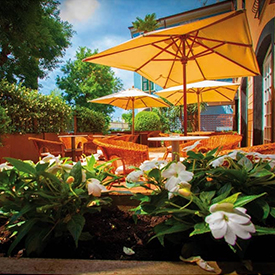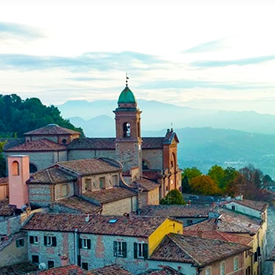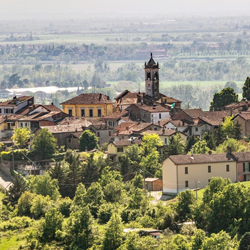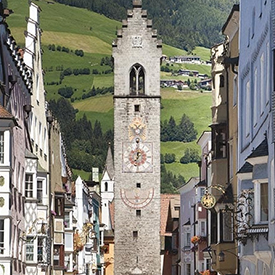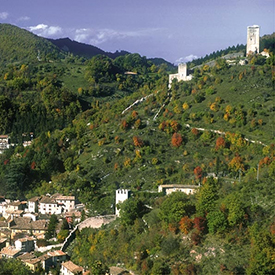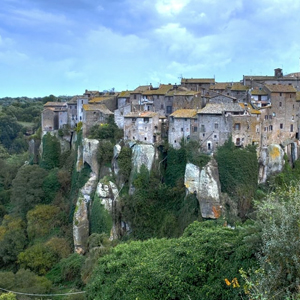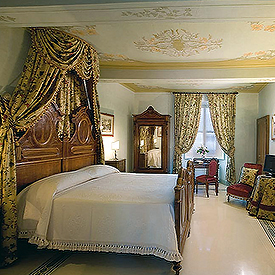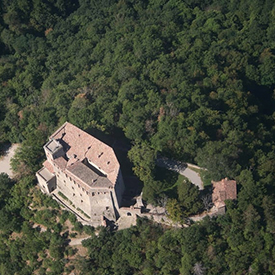The Association “I Borghi più belli d’Italia”.
The Association was founded in 2001 for the initiative of ANCI (the National Association of Italian Municipalities) with the aim of valorizing and promoting the great historic, artistic and cultural heritage of the Italian small centers.
It consists of 333 selected and certified Borghi, whose distinctive trait is BEAUTY and which represent the concept of Made in Italy as an expression of the Italian excellence.
The “Quality Charter” of the Association selects a tourist network of excellence, composed of towns appearing under a common brand name and logo, whose activity in tourist welcoming, maintenance and development is continuously monitored. The Quality Charter lays down the criteria to award the label of I Borghi più belli d’Italia and to access the Club. To be eligible the town must:
• Have an architectural and/or natural heritage certified by the applying municipality and/or by the Ministry of cultural heritage and environmental conservation. Historic buildings must prevail over the total constructions and must form an aesthetically homogenous whole
• Offer an heritage valuable for its urban and architectural quality
• Show through actual facts a policy of enhancement, development, promotion and dissemination, satisfying certain criteria
Visit the Most Beautiful Villages of Italy website at borghipiubelliditalia.it to find out more.
Road map, tourist guide, album…whether for practical or leisure purposes, the publications under the “The Most Beautiful Villages of Italy” brand are tools to help you prepare an escapade as much as they are an invitation to the simple pleasure of discovery.
THE VILLAGES
Situated on a tuff cliff at over 800 meters above sea level, enclosed between the Bradano river, which here draws a wide valley, and the Fiumarella stream, it is really the caelsae nidum Acherontiae, the “eagle’s nest of the Acerenza ”described by the Latin poet Horace born in nearby Venosa. The town follows, from the urbanistic point of view, the typology of the medieval walled citadels.
You enter the village from two main entrances. The first, through the “Porta Vecchia”, leads to the oldest part and salt for the “cordoni”, a steep and winding road to the top of the historic center. The second is that of Corso dei Lincei, the main street that leads directly to the heart of Acquasparta, the square named after Federico Cesi, founder of the Accademia dei Lincei in 1603.
The trulli have been a World Heritage Site since 1996 with the following motivation: “they represent a site of universal and exceptional value as they are an example of a form of construction inherited from prehistoric times and survived intact, albeit in continuous use, up to our days”. There are five Unesco heritage sites: the Monti district, the Aia Piccola district (the only area of the town without shops), Casa d’Amore, the Trullo Sovrano and Casa Pezzolla.
The Norman castle built in the 11th century, supplied up to the Aragonese period with four cylindrical towers placed at the corners and corresponding to the four cardinal points, in the 16th century it was transformed by the Loffredo into a noble residence. In 1825 it was bought by the Susanna family, Marquis of Sant’Eligio.
Amatrice, a town built at the foot of the Monti della Laga in the Middle Ages, together with its 69 hamlets (called “ville”), is well known for the over 100 churches in the area. It is mentioned for the first time in 1012. Since 1991 it is part of the Gran Sasso Monti della Laga National Park, celebrated in Amatrice in the “Parco in Miniatura”.
Anghiari is a beautiful medieval village overlooking the green valley of the upper Tiber.
This corner of Tuscany saw the passage of Thomas Becket in 1164: the Archbishop of Canterbury obtained from the lords of Anghiari the charcoal kilns of the Castle where the Spedalieri di Sant’Antonio, his companions, built an oratory. On it was later built (XIII-XIV century) the church of Sant ‘Agostino, enlarged in 1464 following the collapse of the bell tower.
“The mountains plummet, chipped, burned, scary; the river gurgles among the boulders, falls into waterfalls, escapes in streams, gathers in ponds “: this is the scenario – described by an observer in 1912 – in which Anversa is inserted. The village rises about 600 meters on a wide spur that dominates the mouth of the gorges carved by the Sagittarius river.
Apricale is unique. Set scenically around the small square, it has a soul in steps, with the old stone buildings that develop in height on several levels: it so happens that the entrance is on the top floor and you have to go down the stairs to access the rooms. Apricale means poems made in the street, artists’ studios, refuge for travelers who have found the locus amenus in which to listen to the elves or the owl in the woods.
The village vibrates with silence, encloses in its views, in its paved streets, in its panoramas, the ardor of youth that dissolves in melancholy, perhaps reflecting the mood of Petrarch when he established his final residence there.
But it also highlights the luminous aspect, given by the light stone of its houses, its churches, the palaces that the Petrarchist fashion has had built by wealthy families who came from Venice.
The village of Arrone is located on a rocky hill along the left bank of the Nera river, a short distance from the Marmore waterfall. Once an important commercial hub on the road between the Duchy of Spoleto and Abruzzo, it remains a place of great charm, not only for the medieval appearance typical of many Umbrian villages, but for the environmental context.
The village is accessed through the monumental Porta dell’Arco, one of the three main entrances to the ancient city. Restored and enlarged in the 18th century, it was heavily damaged during the Second World War. In 1948 it was rebuilt larger than the previous one, to facilitate the entry to the means of reconstruction.
The many new houses, poorly built, in the suburbs, do not make clear the reasons for the classification of Atzara in the most beautiful villages in Italy. At first glance, it seems that only the fascinating environment of the Mandrolisai, with the sinuous hills dotted with vineyards, justifies a visit. Instead there are at least three reasons to get here.
Badalucco, a town in the Valley of Argentina, is one of the most important localities for the cultivation and production of olive oil in western Liguria, with the presence of old oil mills and mills, many of which are still in operation. The streets of the old town are an open-air museum with murals and ceramic works placed on the exposed stones and plaster of medieval houses.
Today the old town experiences an original model of generalized slow hospitality as a “hotel town”, with an integrated town-beach tourist system, with several restaurants and new tourist-commercial activities and services, a good cultural offer and many restored historic houses. their northern European or American owners reopen for the various seasonal holidays (many live there year-round).
The main elements of the medieval castrum of Bagnara are the city walls, the civic door, the earthenware, the bastions, the pits and the Sforza fortress which is the seat of the Castle museum.
The archpriest church of Santi Giovanni e Andrea houses the Mascagni museum and the parish museum.
Land of great natural beauty and historically a crossroads of villages and travelers, known for its famous thermal waters, Bagno di Romagna is located in the Casentinesi, Monte Falterona and Campigna Forest National Park. The thermal water here comes out at a temperature of 47ºC and, since Roman times, it has been known for its healing properties, a characteristic that has made the ancient town one of the most famous spas in our country.
The urban structure of Barga has remained more or less the same as that of the communal age (XII-XIV century), marked by the spiderweb of the roads that open between the irregularity of the buildings.
Enter the village from Porta Reale and take Via del Pretorio, crossed by alleys and carriage roads.
On 25 November 1943, in the middle of the Second World War, it suffered serious damage due to a tremendous explosion that shook the area: a German train loaded with ammunition parked in the station below blew up, creating a blast that raised roofs and destroyed the walls of the old village, forcing the population to abandon it and making it uninhabitable for a few decades.
From the municipal archives it was possible to verify that the first historical documents preserved indicate the existence of the nucleus of Bellano in 905 when the upper loggia of the archbishop’s palace became the seat of the court for the dispute between the Monastery of Sant’Ambrogio in Milan and the lands of Limonta, but probably for some centuries already, the city was owned by the Archbishop of Milan, who had established his residence there.
The industrial history of the village becomes concrete, the ancient forges now the Forging School, the seventeenth-century factory of the Fucina Museo and the equally seventeenth-century Mulino Museo – which can be accessed by descending from via Ripa – capable of producing excellent polenta flour with the millstones moved by the water of the Vase King.
Bobbio appears in the distance, in the upper valley, between the sinuous line of the Ponte Gobbo and the bell towers of the Duomo and of the basilica of San Colombano. To start his story was Columbanus, an Irish monk in the odor of sanctity, who built – in the place where the castle now stands – the first nucleus of what would become a great monastic complex, a lighthouse of culture – like Montecassino – for the its schools, the scriptorium and the most important library of the high Middle Ages.
Frescoes that can be found along the streets and on the facades of the houses, where the image of the Madonna is not missing to witness the devotion of the inhabitants, here are two examples. As soon as you arrive in the village, you can not fail to notice, on the façade of the house in Via Giusti 24, the fresco dating back to the sixteenth century that depicts the Madonna in Throne nursing the Baby Jesus.
The history of Borghetto is that of an important crossing point and of a border area contended by opposing armies. The ford of the Mincio was the most comfortable and safe south of Lake Garda, and the river a natural barrier, over the centuries, between the lands of Mantua and those of the Verona area, in a border area targeted by lords and armies that here they had their appetites: the Gonzaga, the Scaligeri, the Visconti, the Serenissima of Venice, Austria, France.
The palm-trees of the riverfront moved by the wind, the line of low houses of the Tanneries, the paths in river stone of the medieval quarter; and beyond, the green in its shades, the blue sea and, if you are lucky, the flight of the griffin around the Malaspina Castle. This is Bosa: a place with a strange charm, uncertain between river and sea, with indefinable colors, strong but introverted feelings, like those who feel well rooted in their culture.
From the balcony of Bova, situated in a panoramic position at 850 meters of altitude, it is possible to embrace the entire coastal arc. The village is one of the most important centers of the Greek island of the province of Reggio Calabria and boasts a long history of which many traces remain in the town.
Now that the historic center, with its dense network of narrow streets, alleys and small squares, has finally been freed from cars as befits a village of art, we can go to the discovery of Boville in complete tranquility. We begin the visit from Porta San Nicola, where the majesty of the walls with its towers immediately springs to mind.
The village is leaning against a chalky cliff and dominated by three rocks of selenite on which rise the Rocca, the Clock tower and the Sanctuary of Monticino.
On the opposite side it was defended by two concentric lines of walls still perceptible in the houses that have incorporated them. Within the historical part, the medieval atmosphere is preserved in the ups and downs of streets and lanes, in majestic buildings as in low and perched houses, in the alleys in shadow, in hidden corners, in squares and in animated courtyards on feast days and of the market.
Immersed in the natural scenery of the Montemarcello-Magra Park, the secret home of the gray heron, Brugnato stands on the banks of the Vara river. Stones were made from the river to make lime and wood for the fire, when the village was still enclosed in the circle of its moat. The aerial photos make it possible to distinguish the central elliptical core, built around the bishop’s citadel as a fortified village with a circular plan.
Fractured by earthquakes (the last in 1984) and with a tourist vocation still to be consolidated, Bugnara appears to be almost resigned to appearance, without something particularly striking. But so much is the desire to get back on track, to recover what has been left to neglect, that the administration has bet on entering the most beautiful villages in Italy.
The robust fourteenth-century city wall, which preserves the Sienese character in its architectural form, once enclosed the whole village like a butterfly in a cocoon. On it there were no openings, except for two access doors equipped with robust wooden fixtures with fittings: Porta Senese on the north side towards Siena, and on the south side Porta Romana, destroyed in 1944 by the retreating Germans.
The village is a maze of alleys, “sporti” and stairways overlooked by well-made portals. It has a torn and earthy air, and a belvedere – where the monumental statue of San Ciriaco is placed – from where the view extends over the marine park of the Riviera dei Cedri and the Gulf of Policastro.
A maze of alleys and streets, interspersed with “wrinkles”, the characteristic squares on which the doors of the houses open directly: Caccuri stands on a spur overlooking the left bank of the Neto river, between the Sila plateau and the Ionian sea . These open spaces, in the long summer evenings, have always been the focus of social life, with families and friends who come together to chat, tell each other about life, imagine a future.
The historic core maintains its medieval layout and boasts Norman origins linked to Ruggero d’Hauteville (Altavilla), from whom it received a first major contribution to urban development. On the edge of the Val di Noto, in the heart of Sicily, stands on Mount Xibet Calascibetta. The geographical position has always been a strong point of the town and its inhabitants–
Campiglia Marittima can be encountered when arriving from the sea, or from the hinterland. In the first case there will be a compact village covering the top of two gentle hills, the slightly higher one dominated by the Rocca; in the second case you will have a less defined view, which comes out of the green, and as you arrive, you will be welcomed by a maze of streets and alleys interspersed with characteristic squares, with buildings on whose walls you can read the transformations of time.
An evocative pilgrimage on foot is held every year with all the hamlets and a solemn vigil open the religious celebrations; characteristic is the Sunday votive procession that crosses the whole historical center of Campli and Castelnuovo, accompanied by the sound of the Band and by the parades in dress of the Marian brotherhoods.
On the ancient village of Campo Ligure the castle stands out, also visible from the motorway, restored and used for concerts and cultural initiatives. Its external wall structure could date back to the XII-XIII century, while the tower is of more recent age. The Spinola family made it the sentinel of the village and of the Stura valley. Fortified again in 1310, the castle was abandoned in the eighteenth century.
Canale di Tenno is a rural agglomeration of medieval origin (it has been reported since 1211) survived almost intact in its structure up to the present day. The village is appreciated for the characteristic architecture made of “faces” barrel, underpasses, alleys, balconies smoked by time. Along the road that leads from Canale to Calvola, in a panoramic square there is a group of statues representing the “Vicinia”, a memory of the collective management of the typical assets of this community.
At Easter it is the turn of Capalbio in Fiera, an event dedicated to the country world that takes place in the hamlet of Borgo Carige, with demonstrations organized by the local Maremma Butteri and with tasting of local products. In May, on the 20th, San Bernardino da Siena is celebrated as the patron saint of Capalbio with a solemn procession through the town, while the COSC and Ri.Vi.Vi associations.
The village was founded in Longobard period on a promontory at the confluence of two rivers, the Orfento and the Orta. The main path develops on the line of the ridge, with atop the fortification, which had to be defended not only from the castle, now reduced to ruins, but also from the same main church, the almost millenarian abbey of Santa Maria Maggiore, equipped for this purpose with robust walls.
The two urban centers of Cassinetta and Lugagnano, located on the opposite banks of the Naviglio Grande, are connected by a donkey bridge. The bridge over the Naviglio was rebuilt in 1862 to facilitate navigation on the canal. Next to it is the statue of San Carlo Borromeo, built in 1749 to commemorate his brief halt in 1584: he was ill and stopped here while sailing on the Naviglio to Milan, where he would die shortly afterwards.
El centro histórico del municipio de Castagnole delle Lanze, en el pueblo de San Pietro, en lo alto de una colina, se caracteriza por edificios residenciales que datan del siglo XVIII y destacan la iglesia parroquial barroca de 1701 (San Pietro in Vincoli), la iglesia de San Rocco y la cofradía de los Battuti Bianchi.
Castel del Monte (Italian for “Castle of the Mountain”; Barese: Castídde d’u Monte) is a 13th-century citadel and castle situated on a hill in Andria in the Apulia region of southeast Italy. It was built during the 1240s by the Emperor Frederick II, who had inherited the lands from his mother In the 18th century, the castle’s interior was removed.
Panoramas among the most beautiful in Lazio in the scent of broom and thyme. Castel di Tora stretches along the banks of the Turano artificial lake, surrounded by a crown of thick woods dominated by the Monte Navegna (1506 m.). From the top, on the clear days of the tramontana, one can admire the dome of the basilica of San Pietro in Rome with the naked eye.
Coming from Rome, the sumptuous villa that Cardinal Flavio Chigi had built in the 16th century is found on the Via Nettunense, in Laghetto. From the upper area of the park a staircase leads to a nymphaeum with painted walls. Once back on the Via Appia, the church of San Sebastiano appears on the right.
In winter, the artistic nativity scene with life-size characters is housed in the fortress of the Colonnas, where an entire village is reconstructed with huts, the mill, the fountain and the representation of the crafts and the nativity. Christmas Sundays of artistic crafts are held on Sundays in December.
The crags and gullies of the Valdarno between Florence and Arezzo attracted the scientific attention of Leonardo da Vinci, who used them as a background in various paintings and drawings. Particularly fascinating are the crags of Acqua Zolfina, not far from the panoramic road of the Sette Ponti from which, at the crossroads with the provincial road of Botriolo, you can see the medieval tower of Castelfranco framed by gullies.
Castell’Arquato is an art village of rare beauty pervaded by atmospheres of other times. It has low brick-colored terraced houses and narrow cobblestone alleyways that lead to the top of the hill, where the wide monumental square opens up, which seems incredible to find in such a place, in this Val d’Arda that fades from one side to the street Emilia and Padania, on the other towards the hills of Vernasca (and the Apennines) with the jewel-village of Vigoleno.
The fortified village of Castellaro is reflected in its heart-shaped pond, a corner of the Garda morainic amphitheater that has been the subject of careful care by the administration. The ancient Guelph walls, the river-stone pavement, the visible stones of the rectory and the houses have been saved: like the one wrapped in creepers, in front of the Arrighi-Tacoli villa, which one would never get tired of looking at because it remained intact since the thirteenth century.
Between snow-capped mountains and vast woods, clinging to the rock, stands Castelli, the starting point for ascents to the Gran Sasso and known for the production of painted majolica, which perhaps began with the Benedictine monks (an unconfirmed theory gives the merit even to the Etruscans).
Situated between the Mantovano, the Cremonese and the Parmense, territories of flourishing agriculture, the village of Castelponzone represents an example of recovery of the rural dimension. In Castelponzone the intertwining of agriculture and the village has been so strong in the past that it cannot be removed.
The territory of Castelrotto is largely included in the Sciliar Natural Park. The language that governs Kastelruth – this is the German name – (Ciastel in Ladin) is that of the “picturesque”: in the sense that many facades were decorated by a painter, Eduard Burgauner (1873-1913), whose intent was to transform Castelrotto in a work of art.
Perched on a large promontory overlooking the sea, Castelsardo with its neighborhood of the Cittadella, or Casteddu – that is to say the labyrinth of twisted streets of the ancient village – offers a vision of great charm. In fact, from any perspective you look at it – excluding from the district of Pianedda and the coast of the Marines – the promontory of Castelsardo offers postcard views.
Castelvecchio is the first and most beautiful of the walled villages of the Val Neva, wrapped in a circle around the castle that dominates it. The castle was built by the Clavesanas in the 11th century, when the place was still called Vallis Cohedani, a mysterious toponym that identified one of the main “salt roads”, capable of connecting the Piedmont plain with the western Liguria through the exchange of oil, wine, wheat, timber.
The circle of walls and towers that still today compacts the village within its happy isolation, is the one built by the Lucchese in 1371. The robust profile of the curtain wall opens in the center on the “piazzola”, where the door of the drawbridge has two towers that make it a guard, that of the Clock, rebuilt, along with the tower, after the collapse of 1920, and that of Fattori, which still keeps the drains intact.
Castroreale offers a synthesis of art and nature in every corner. If you look away from the monuments, this immediately runs to the splendid surrounding views, such as the one on Capo Milazzo and the Aeolian islands that can be admired from the viewpoint of Piazza delle Aquile along the eastern side of the cathedral.
The cathedral is the axis on which the entire historic city still rotates, inserted in an environment of great charm, between the vast marine horizon and the squat mountain to which it is leaning. The fortress that overlooks the city, already known to the Phoenicians as “Ercole promontory”, is a 270 m high limestone rock, from whose top you can enjoy a splendid panorama.
Cella Monte is located in the rolling hills of the Monferrato Casalese, a land of vineyards and the production of appreciated wines such as Grignolino, Barbera and Freisa. In some wineries in the country it is possible to combine the wine tasting with the visit of the winery and their infernot.
The countryside around Cetona is so beautiful that it almost looks like an oleographic representation of a Renaissance landscape.
The walls, which once had three turns, today preserve the most important trace of the third circle in the round tower of Rivellino, dating back to the mid-sixteenth century.
The long road that crosses the city is the first attraction of Chiusa. Walking along the ancient core from Città Alta to Città Bassa, the first historic buildings that meet are the Wegmacher House and the church of the Apostles, in Gothic style with a single nave, built by the master-architect Jörg in the second half of the fifteenth century.
The warm colors of the plasterwork of the facades that follow one another along the main artery of the city, harmoniously interspersed with the austerity of the stone exhibited by the elegant Renaissance portals. The feeling of calm and rare timelessness is reinforced by the almost total closure of the center to automobile circulation.
An ancient political and administrative center of the county of Valmareno, the village of Cison is guarded by the Brandolini castle, called in the Middle Ages Castrum Costae and today – now a luxury hotel. The fortified complex (XII century) was transformed by the Brandolini counts with the addition of the Renaissance wing and the raising of the external walls and bastions.
Più che un borgo, Città Sant’Angelo è una cittadina e bisogna dunque cercare il centro storico facendosi largo tra le urbanizzazioni della collina e quelle del mare. Dal belvedere naturale su cui è stata costruita, si gode una vista magnifica sui monti della Maiella e del Gran Sasso e sulla molto rovinata costa pescarese.
In the heart of the Pollino Park, nestled between the rocks to make itself invisible to the raids of the Saracens, Civita is a treasure chest that preserves the ancient traditions of the Arbëresh people. The valley in which it stands is surrounded by wooded mountains, where the blue reflections of the Ionian sea arrive, which can be glimpsed on the horizon.
The tuffaceous hill on which Civita stands is undermined at the base by the continuous erosion of two little streams flowing in the valleys below and by the action of rain and wind: it is therefore crumbling, slowly but inexorably. The village, where only a few families now live, is collapsing and evaporating, it is going astray: tomorrow will only be a mirage, like the most beautiful dreams, like Venice, like everything that reveals fragility, human impotence.
A top warrior suspended between sea and mountains: this looks like Civitella del Tronto. Elevated on a mighty granite boulder on the road that joins Ascoli and Teramo, the village is able to amaze in every season, both when the woods on the sides of the mountains catch fire with bold colors, and when the winter sprays the tiles with snow.
The village of Clauiano maintains a precise identity as a whole, where the stones and the pebbles, piéris and clàps, still speak, are the decorum and ambition of the portals, the environments of rural life – the fogolâr, the foledôr, the granary – and the many and small traces left by history: that here is not that of the great architectures and of the great events, but it is that dictated by the compelling necessities of everyday life.
The locality that today is called the “Riviera del Monferrato” for its mild climate, was probably founded by the Ligurians. The Roman presence is documented in the town of Marcellina, and to it is connected the legend of the Pietra Cagnola, a massive gold simulacrum in the shape of a dog which, placed on the harrow, was believed to have the power to make the earth fertile.
The baronial castle, as it appears to us today after the restoration of the last century and the one of the last years, shows in the general layout the imprint of the restructuring operated by Baron Alfonso Soderini in the second half of the XVI century when, besides the palace, also the fortress it was remodeled to be transformed into an artillery fortress.
Colletta di Castelbianco was only a picturesque heap of ruins when someone had the idea of saving it from complete destruction, making it the first European example of a telematic medieval village. Entrusted for the restructuring to the care of a famous architect, Giancarlo De Carlo, today looks like a bridge between past and future, with its stone houses that dominate the hill, the alleys, the squares, the terraces, the framed windows of white according to the tradition of the Savona hinterland, and all the telematic equipment that allows teleworking or in any case connectivity with the rest of the world.
“We will return to our mountains …”, sings Il Trovatore by Giuseppe Verdi. To our mountains. Set on the road that links Emilia to Liguria, among the woods of the Parma Apennines rich in mushrooms and arboreal penumbres, Compiano is the typical castle of the medieval town flourished around the defensive rampart of the Alta Val Taro.
Corciano is located between Perugia and Lake Trasimeno, on the top of a hill guarding the valley passage that connects the Trasimeno and Tuscany territory to the Tiber valley. The original castrum, built in medieval times, is of the “a poggio” type, with a concentric road system, enclosed in a triple circle of walls (XIII-XIV century).
The current fortified area of Cordovado, known as the Castle (XI century), is the result of changes and stratifications that have occurred over time, particularly between the sixteenth and nineteenth centuries. In the late Middle Ages the outer circle of walls, with an embankment, a moat and two towers still today, contained an interior space consisting of the bishop’s castle, which in turn was equipped with walls and a moat with a drawbridge, a keep and other buildings. Next to it rose the village.
We are in the Media Valle del Serchio, the north-eastern part of the province of Lucca, a corner of Tuscany sandwiched between the Apuan Alps and the Tuscan-Emilian Apennines. It is a very suggestive area that combines art, history and nature in perfect symbiosis. The terraces with their vineyards and colorful fields slope down towards the valley of the Serchio river, dotted with villages wrapped in clear, clean air.
We go immediately to the heart of the village, to avoid the impression that the large residential and industrial area that arose in recent decades alongside the E45 state road has obscured its original identity. Umbria in many people’s dreams remains a constellation of ancient villages in a sea of greenery.
Diano Castello was the only fortified village in the valley and four doors opened in its walls. The visit can start from the paved via Meloria, dedicated to the famous naval battle of 1284 which consecrated the supremacy of Genoa over the Tyrrhenian Sea and in which the inhabitants of Diano distinguished themselves.
From the griffin which is watered, depicted in the coat of arms, to the golden nectar of Albana cultivated in a landscape that seems almost Tuscan: there is no better paradox for this village nestled on the first hills overlooking the Via Emilia, between Bologna and Imola, and which opens discreetly to the visitor who walks the paved streets up to the Rocca Sforzesca, powerful, massive, yet well harmonized with the rest of the inhabited area, whose floor plan is like a ship’s hull.
The arcades are the picturesque – to use a pre-Roman term – the ancient market town of Egna. The houses, lined up along the road that served as a market, are equipped with arcades, under which commercial and social activities took place and are still taking place. Arches with rounded and pointed arches follow one another, revealing architectural changes over time.
Along the main road ran the Ritsch, a drainage ditch made of white marble blocks, into which the waters of the Rio Trodena flowed and the draining waters of the arcades.
Pork rinds with beans are the local specialty. They should be accompanied with toasted bread – generally the crescia of wheat or corn flour, cooked under the ashes – and the potatoes used to firm up the sauce. Dried legumes are the raw material for chickpea or bean soup. The skill of housewives is the basis for preparing egg pasta by hand, which can also be seasoned with a crayfish sauce.
The “village” of Fagagna is actually made up of seven ancient and distinct suburbs that the building development of the last decades has “compacted” into a single inhabited center. Starting from the municipal palace, you can climb the castle hill through an old paved road (vicolo Morcjùte and via Cecconaia). At the top is the Community building, administrative and judicial seat of the Community of Fagagna from the early 16th century to 1797, and the ruins of the castle, the oldest part of which dates back to the 11th century.
Those who arrive in Val di Noto to visit Ferla, after appreciating Noto’s Baroque, find a pleasant surprise. You reach the village by crossing the Iblei Mountains plateau, often cultivated with wheat and characterized by the presence of almond trees, centuries-old olive and carob trees, grazing cows and a dense network of dry-stone walls.
Closed between medieval walls still well preserved, interspersed with semi-circular towers and interrupted only at the doors, the Borgo di Finale (so called to distinguish it from the Marina) immediately offers the visitor a feeling of protection and meditation. The ancient defensive and community concept survives in the network of streets, arranged perpendicularly to each other to form fascinating foreshortenings in contained spaces.
Old stone houses, mostly restored, overlook sloping streets, in the typical medieval conformation of the Apennine villages. The surrounding woods form a natural crown on which the peaks of Frignano and Mount Cimone in particular are imposing, which has clung to the scattered hamlets of Fiumalbo.
Waiting for the complete recovery of the historic center, which already gives a glimpse of positive signs, such as the removal of the gates and the elements of degradation from the historic facades, and the parking lots in front of the squares, Fiumefreddo has the look of Calabria that wants to redeem itself and look forward.
From Piazza Castello, the heart of the village, the connection and entrance routes radiate. Via di arc, passing the square, develops via di Mezzo, which has a first downhill section, and then goes up again in the second half to the entrance of the church of Santa Maria Assunta, which constitutes the terminal part of the building Orsini (around 1200).

With Santa Maria in Sanavalle the monastic art, aimed at the creation of beauty, with its arches, capitals and columns and with its play of light, gives us masterpieces such as the Cloister finished in 1268, the wooden crucifix of the Baroque age and the 1527 fresco by Francesco da Milano.
The entrance to the Olimpo of the most beautiful villages of Italy Fortunago owes it to a careful and functional recovery of the atmospheres of the past. The facades all in exposed stone, the wooden doors and windows in natural color, the pavement of the streets in porphyry tiles, the cured and soft lighting make this town nestled on the hills of Oltrepò Pavese a perfect example of balance between modernity and tradition.
The best way to get to know the territory of Framura is to start from the highest village, Castagnola, and go down to the others, Costa, Setta, Ravecca and Anzo, on foot. From the latter, the closest to the sea, you will soon arrive at the train station, from where an elevator leads to the marina. From the station take, on the old railway track, a very pleasant cycle path that reaches Bonassola and Levanto.
The castle that repelled the Malatesta and won the assault of Giovanni delle Bande Nere is perched on a spur overlooking the Mutino valley. High walls, towers, narrow streets and squares paved with pebbles of the Mutino stream, flowers and plants along the terraced houses, quiet cats welcome the visitor.
Lying on the plateau of the Orso hill, at the foot of a mountain of beech and meadows where cows and sheep graze freely, the village has kept its bucolic charm. The visitor is immediately struck by the astonishing cliff of the Morgia Quadra with its bizarre shaped rocks and internal stalactites.
The history of Italy was written in Gaeta. The ramparts of Charles V and the Angevin-Aragonese castle were the scene of the last battle between the Bourbon and Piedmontese armies. The besieged fortress gave way on February 13, 1861. A tour of the imposing bastions built on the slopes of Monte Orlando and other battle sites allows you to relive the dawn of the unification of Italy.
In the agricultural Sicily, in the fresh and mountain air of the Madonie, Gangi presents itself with the color of the stone that gives shape to hundreds of houses close to each other: a fifth compact building in the prevailing lack of plaster, which from afar creates a scenographic illusion evoking imaginary cities, like a Bethlehem Pasolinian or those painted in the fifteenth century by Andrea Mantegna.
You may start your visit from Piazza Doria, dedicated to Prince Doria, Lord of Genoa and Garbagna. On this Renaissance square stand the Doria Palace and the Oratory of San Rocco. In the center there are four horse chestnuts, planted in 1853 with an arc in the middle, in memory of an ancient water source, from which all the population was supplied.
The Savoy Palace is the first testimony of Gardone of the Belle Epoque. Built in 1906 in a Viennese secessionist style, it is one of the three historic Grand Hotels: the other two are the Grand Hotel Gardone (1883), the first world-famous hotel on Lake Garda, founded by Luigi Wimmer, the “discoverer” of Gardone ; the second is the Grand Hotel Fasano.
You can start visiting Garessio from the Borgo Maggiore medieval hamlet: from via Cavour you will arrive to the Porta Rose tower which today houses an art gallery. The oldest part of the borgo (founded in 1100) was surrounded by walls, towers, and gates of which only some traces remain; Porta Rose was the main entrance and was protected by a drawbridge placed between two towers.
Longobard feud until the Norman conquest, Gesualdo is located on a hill overlooking two valleys, that of Fredane to the south and that of Ufita to the north, separated by Monte Otica. The first houses of the village would have been born around the fortress built by the Lombards in the second half of the ninth century.
The sound of fresh sandals makes happy the tourists who land at the port with the promise of summer. In Giglio Porto, a picturesque town with multi-colored houses, the Torre del Saraceno, built by Ferdinand II in 1596, and the Caletta del Saraceno with the remains, visible on the water, of the fish pond attached to the Roman villa of the Domizi Enobarbi deserve a visit.
With its 885 inhabitants, of which 400 live in the village, Glorenza is one of the smallest cities in Europe, perhaps the smallest ever. The walls, the only intact town fortification in all of South Tyrol, enclose an urban layout whose medieval origins are clearly visible, although the architectural forms of the 16th century predominate.
Gradara identifies itself with its fortress. In the beginning it was a simple watchtower built by the Griffo family in the second half of the 12th century. Its fundamental structure dates back to the Malatesta interventions dating from between 1293 and 1324. The most important artifacts remain the keep, the “castellare” and a porticoed wing of the courtyard.
The rural area of Gradella is considered a historical center worthy of particular attention in the regulatory plan of the Municipality of Pandino. It presents itself with the characteristic houses painted in yellow, trimmed with red bricks and with communicating courts.
The porticoed fronts, the ornamental motif of the exposed brick pilasters, the wood as a construction material that goes with the brick, make this village a poetic piece of the Po Valley.
There are four periods of Gradisca: the fifteenth Venetian, the seventeenth century Austrian, the Habsburg nineteenth century and the Italian twentieth century. Conceived by the Republic of Venice as a bulwark against Turkish incursions, which were furious and frequent in Friuli, it was built by the architects of the Serenissima as a fortified village with wide streets that intersect at right angles (to facilitate the maneuvers of the soldiers) and that go to form a regular building fabric, divided into compact blocks of houses.
The historic core of Grazie is represented by the sanctuary of the Beata Maria Vergine delle Grazie and the buildings placed on the perimeter of the square in front. The oldest part is that of the row houses in Via Madonna della Neve, in which one recognizes – despite the transformations that have taken place – the original cell that gave rise over time to the various building types.
Greccio, a small jewel set among the green hills of the Holy Valley of Rieti is certainly one of the most beautiful and picturesque places in the Province of Rieti. The ancient medieval village located 18 kilometers from the capital, perched at 705 meters above sea level on the slopes of Monte Lacerone, still today, both for its position, which enjoys an excellent view.
See Gromo from the top of the pastures and mule tracks, with the piode – the slate roofs – which cover it as a hard and uniform protective covering, it is not enough. You have to enter it, in this mountain town, and visit it calmly, to discover not only the happy combination of the elements – water, timber, good air – but also the artistic riches preserved by this small community.
Still visible on the hill, the remains of the 11th century fortress that dominates the old prisoner tell the ancient history of Grottammare. The soft lights that soften the cycle-pedestrian walkway to the sea, and the wind that blows through the leaves in the lookouts, return to the place the silences and sweetnesses that charmed Liszt and other famous residents.
Starting from Piazza Cavallotti and following Via Vittorio Emanuele II, one enters a long perspective telescope closed at the bottom of the civic tower. As you approach the main square, the entrance arch of the tower gives a glimpse of the facade of Palazzo Bentivoglio, giving the impression of a space as vast as that of a fortress.
They call it “the village with stone houses”. Guardia is a village that can be walked slowly, crossing the benevolent eyes of women on the doorstep, and it is not rhetorical to think that the director came here when he came to shoot the sequences of “Christ stopped at Eboli” Francesco Rosi has found that atmosphere of a lost country elsewhere.
The particular position in the face of the Maiella explains the alternate use of stone and brick in the historic core, whose urban fabric was formed between the thirteenth and fifteenth centuries, when the walls, from the original Longobard garrison, reached their maximum development on the acrocoro.
Ingria is a municipality of scattered villages in Val Soana, north of Turin, in the Gran Paradiso National Park. Among the main attractions of the area, the bell tower of Ingria, in front of the parish church of San Giacomo, dates from 1719. In Mombianco it is the small church that attracts attention: built in 1647, it is dedicated to the Holy Shroud, perhaps for a transit of the sacred linen during the journey from Chambéry to Turin, coming from the Lanzo Valleys.
The Cathedral of Santa Maria Assunta preserves the crypt and the Romanesque and Gothic bell tower of the ancient church. At the rear it looks like a fortress and forms a single body with the city walls. Inside you can admire the fifteenth-century works of the De Mabilia donation, with the sculpture of Sant ‘Eufemia by Andrea Mantegna purchased in the workshop of the Paduan master.
La Maddalena has an “official” history of just 250 years, but its position in the Strait of Bonifacio has made it strategic since ancient times; stop of the prehistoric travelers who brought obsidian and flint to the European continent, then of the Roman ships that put Spain and Turris Libissonis in contact with Rome; seat, in the Middle Ages, of solitary monks important protagonists in a delicate phase of the history of the Giudicati, intermediaries between the Giudicessa Adelasia di Torres and the Pope.
With its narrow streets, the small squares to the sea, the pink-lilac tones of the houses in the protective shade of the monumental church of San Matteo, Laigueglia preserves the charm of an old fishing village that most of the Ligurian coastal municipalities have lost.
From the beach that in winter is filled with colorful boats and nets, and even more from the pier undergoing redevelopment, you notice the particular shape almost like an amphitheater of the town, which is the only one that has not altered much the shape of buildings, maintaining their volumes and heights.
To the visitor who goes up here, among the olive trees, from the beautiful road of the Batteries that carries the scents of the sea, Lingueglietta presents itself with the characteristic newly renovated and paved alleys, oriented in a longitudinal direction and connected by ramps and covered passages, vaults and arches of clear medieval imprint. The houses, located overlooking the valley, are tightened together to form a natural defense curtain, which replaces the walls here.
The white Locorotondo is the most beautiful balcony of the Murgia dei Trulli. From its lookout you can admire a territory that is sometimes exciting: a mosaic of small vineyards marked by dry-stone walls, patches of Mediterranean woods and silvery olive groves that surround ancient farms, thousands of trulli scattered in the districts.
The roofs broken down or covered with clay tiles, the vines that cling to the crumbling walls, the rare houses inhabited by elderly people who exhibit a vase of flowers or a window surrounded by blue: Lollove makes a lot of melancholy but it has seeds in it of rebirth. Low stone houses, narrow cobbled alleys: the origin of the place is clearly medieval.
Loro Ciuffenna is located between the Arno and the hills that are a prelude to the Pratomagno mountain. All around, the Balze, curious natural formations of clay and sand up to a hundred meters high, which characterize the territory of the nearby village of Castelfranco. With its ridge of gentle slopes, the Apennine massif of Pratomagno is a mixture of grass, rock and wood that guards a Tuscany of forgotten villages and Romanesque churches.
Luserna is a small village where history, culture and traditions have merged to create a solid and recognizable identity. The leitmotif of this identity is an ancient language of Germanic origin, Cimbrian, dating back to the first centuries of the second millennium and still spoken daily by 80% of the population, legally protected and recognized at regional and national level.
The town of Macerata Feltria is divided into two parts: at the top, the early medieval core of the castle, of Lombard origin; below, the late-medieval and Renaissance part, called borgo or Mercatale, because its extension in the 16th century took place on the area of the old market. It is from here that one enters coming from Pesaro and the Val Foglia.
On the eastern shore of Lake Garda, on the slopes of Mount Baldo, Malcesine is a charming town that all visitors, Italians and foreigners, fall in love with. The historic, medieval center is dominated by the Scaliger castle, a must-see both for the impressive views of the territory (from the Rivellino platform and the tower) and for its cultural and artistic wealth.
The charm of Maruggio widens in the splendor of its landscape, dominated by mighty olive trees, and characterized by Masserie, Votive Chapels, majestic Trulli and dry stone walls that line the luxuriant rows of vineyards, where the prized primitive wine is born, with its unique harmony of colors, scents and flavors.
Of medieval origin, Mercatello sul Metauro is a charming town of the Alto Metauro, perfectly set in the green valley of this river, immersed in a landscape that is still intact and harmonious. Anthropized by an ancient peasant civilization, the valleys and hills are dotted with a number of farmhouses where the typology of the Tuscan farmhouse is often highlighted.
A stone’s throw from Fiera di Primiero and San Martino di Castrozza, Mezzano is a sort of reservoir of alpine life, an inexhaustible mine of ideas that are offered to the traveler in every hidden corner, along the alleys, in the squares, in the shadow of the walkways transforming it into a vibrant museum under the sky.
Miglionico est un village qui se dresse au sommet d’une colline entre les fleuves Bradano et Basento, dans une magnifique position panoramique sur la réserve régionale du lac San Giuliano et les vallées environnantes. La première chose que le visiteur remarquera depuis la route est l’imposant château de Malconsiglio, où s’est produit l’événement historique qui a fait la renommée du village : « la conspiration des barons » contre le roi Ferdinand Ier d’Aragon.
The many rock necropolises scattered throughout the territory testify to human presence as early as the third millennium BC. With the Greek colonization, starting from the sixth century. BC, the evidence of the first inhabited areas becomes more evident. The current village may have originated in the Byzantine era (6th-9th century) by re-adapting some necropolises in dwellings clinging to the crags extending towards the Loddiero river valley.
In Millesimo it is necessary to concentrate on the historic center, whose characteristic triangular shape, having as its vertex the castle and as a base the Del Carretto palace, is clearly visible from above, and in all the maps of the time, eg. in the Napoleonic one of 1806, where the layout of the ancient medieval walls with towers and four access doors is clearly visible. We must therefore cut out the “new” formless Millesimo which grew up behind the ancient town.
Immersed in the “calanchi”, narrow, steep-walled limestone inlets, like an oasis in a tuff desert softened by brooms, Mombaldone is the only borgo in the Langa Astigiana, still surrounded by the original walls. Walking along its only central street, from which alleys and passageways depart, archived and courtyard is like taking a journey back in time.
Porta San Francesco is the main entrance to the village. The last remaining passage, of the three that opened onto the walls, is located in the keep of the Rocca; and already from the access ramp it is possible to admire the magnificent proportions of the keep with its scarp base. The fortress is the masterpiece of Mondavio.
The heart of the ancient castle is the large central square dominated by the municipal residence built with the neogothic style civic tower in 1931, with bricks recovered from the ancient town hall destroyed by the earthquake of the same year. It is a large body in masonry facing, from which alleys and staircases radiate in different directions.
In the 12th century the Genoese put two fortresses in defense of Moneglia: that of Villafranca, to the east, was destroyed during the last war and partially recovered some twenty years ago; on that of Monleone, to the west, in the early twentieth century a curious Coppedè style castle was built.
The walls that surround Montagnana, reinforced by 24 hexagonal towers with Guelph battlement, have four openings at the doors and show all their grandeur from the northeast side: the same observation point adopted by Giorgione when he depicted them in the sanguine drawing of the Boymans-Van Beuningen museum in Rotterdam.
The “Jerusalem” of San Vivaldo: one of the most significant examples of reproduction of the holy places in the West for the purpose of a substitute pilgrimage. A citadel of chapels and small temples, built in the woods by the Franciscan friars at the beginning of the sixteenth century, which reproduces in scale the topography of the Jerusalem of the time and houses sculptural groups of the Della Robbia school inspired by the Passion and life of Christ.
The most significant historical architectural element of Montalbano Elicona is the castle that dominates an irregular and tortuous medieval urban fabric, which winds up and down the alleys adapting to the shape of the rocky promontory. The small houses built in sandstone are full of authentic history.
Monte Castello di Vibio clearly preserves the appearance of a medieval castrum. It stands on a hill, from which you can enjoy a unique view of the Umbrian hills and the middle valley of the Tiber. From a distance, were it not for some recent construction and scattered farmhouse, the village seems almost drowned in the green, with the red cap of the ancient tiles that still cover the beautiful stone dwellings.
This small village of Montefeltro has an urban “spiral” layout, with narrow streets that climb up to the top of the slope, from which it overlooks the valley of the Conca river. The historic center is squeezed between this cliff of almost three hundred meters above the valley, and the ancient castle, of which the civic tower remains.
Di Monte Isola, the largest island of European lakes called “the Capri of the north”, Siviano has always been the capital. It lands in the hamlet of Porto, in front of a cluster of old houses, you can admire the small church and the villa Solitudo, and climbing up we reach the center of the town, where the imposing tower Martinengo dominates the town hall square.
Monte Sant’Angelo was born around the Grotto of San Michele Arcangelo and its Sanctuary. After the three apparitions of the Archangel, an international pilgrimage that has never been interrupted for 1500 years begins. Byzantines, Lombards, Normans, Swabians, Angevins and Aragonese the pilgrim peoples to the Archangel who have left traces here that today are monuments of beauty.
Montecassiano dominates the hill between the Monocchia stream and the Potenza river. Its medieval identity is enclosed between the high walls, built starting in 1437, which still surround the historic center and separate it from recent buildings. The urban structure develops in concentric streets that culminate in the central square following the ascending conformation of the hill.
The fraction of Tenaglie belonged to the family of the Basques who in 1412 built a hospital for pilgrims there. The Ancajani family is responsible for the late seventeenth century building that dominates the village. All in stone, Melezzole is a medieval castle with a circular plan, with a tower bearing the Tuderte eagle from 1557.
The medieval village of Montechiarugolo rises towards the 10th century, following the deforestation carried out by the Augustinian monks of the abbey of Santa Felicola. In 1121 the original defensive castle was built at the behest of the Sanvitale family and in the following centuries the castle passed to the Visconti.
A few km divide the historic center from the new settlement of Montecosaro Scalo, site of commercial and industrial activities that besiege one of the most important monuments of the region, the Romanesque basilica of Santa Maria a piè di Chienti. Probably of Lombard origin, it is known from 936 and two epigraphs tell us that it was commissioned by the abbot Agenolfo and consecrated in 1125.
The first thing that strikes you is the overall view: this village seems to have changed little since the 1400s. Its medieval urban layout in an elevated position gives the small inhabited center an evocative eye-catcher. Merit (so to speak) of the lack of resources, if this castle equidistant from Pesaro and Urbino has not been tampered with, preserving the ancient characters over time.
The oldest settlements, dating back to the early Middle Ages, have all the characteristics of the fortified village or castle, at the top of a hill or a ridge, sometimes close to a feudal or even late Roman pre-existence. Compared to nearby castles such as Panzano or Cintoia, Montefioralle is the one that has been best preserved, thanks to its isolated position on a hill overlooking the high valley of the Greve river and the ridge of the Chianti Mountains.
The Malatesta fortress, “medieval skyscraper that seeks light” – according to the beautiful definition of Ugo Amati – is the most powerful symbol of Malatesta power in the whole Conca valley. It was the Guastafamiglia who expanded it and turned it into a permanent home around 1337. The current form, despite the changes made in the 15th and 16th centuries, does not differ much from the original planimetry.
Montefiore dell’Aso is a delightful village in the Piceno area, set on a hill between the valleys of the Aso river and the Menocchia stream. Its horizon ranges from the Sibillini Mountains to the sea, just a few kilometers away. The historic center is quite well preserved: there are still significant stretches of walls with doors and six towers dating back to the 15th and 16th centuries.
Starting from the entrance tower, the Malatesta castle, which encloses the ancient village, presents itself with an appropriate restoration, where everything is in the right place because it tells us how it was at the beginning and how it has been remodeling over the centuries. This contributes to creating the impression that the life of distant times that was inside has not been completely lost.
The church of San Francesco at the end of the fourteenth century was divided in half, in height, by strong vaults. The lower church has two naves: the central one shows a coffered ceiling from the eighteenth century. Among the works of art preserved: a wooden statue of Sant’Antonio Abate; an early fifteenth-century fresco depicting the Madonna del Voto; the baroque altar dedicated to San Felice.
Among the blue Monti Sibillini and the sea of the Conero, Montelupone is one of the small towns of the Marche that has best preserved the testimonies of its rich history: it can be understood immediately observing the long castle walls with the four entrance doors, and the original stone paving of the village.
From Bocca di Magra, a small village at the mouth of the river, already a summer refuge for Roman patricians, as Persio Aulo Flacco tells us and testify to the remains of a villa from the imperial period, the journey begins to discover this strip of Ligurian land at border with Tuscany.
Inside the triple circle of the medieval walls the village is intact. The oldest circle contains the upper part of the town called “castello”; the second, fortified by the Sienese with three circular towers at the beginning of the fifteenth century, protects the neighborhood built in the thirteenth century under the Aldobrandesca fortress; the third is an addition to complete the defensive structure and joins the church of San Giorgio and the new quarter of the first half of the fifteenth century.
Stop the illegal building, the advance of cement, the absence of regulatory plans: Monterosso Almo takes the virtuous path of protection and restoration, and is therefore ready to show the visitor his jewels, starting from the vast Piazza San Giovanni, finally freed from cars, called in dialect u chianu, the piano, in relation to the up and down movement of the village, which follows the curves of the mountain.
From the square of the Castle, on clear days you can see the islands of Gorgona and Capraia and, if you’re lucky, even the northern tip of Capo Corso. Letting your eyes wander down from the city walls, you can see the hundred cottages of the village below with their characteristic roofs covered with Tuscan tiles.
Due to the centrality of its position, the village of Morro d’Alba has always been of great strategic importance since the earliest centuries. The oldest evidence of human presence dates back to the Paleolithic and Neolithic times. In the hamlet of Sant’Amico, testimonies of a Roman settlement that disappeared following the descent of the Goths were found.
As in the Invisible Cities of Italo Calvino, the lost grace of many places in the Italian province can now be found only in old postcards, where everything seems more beautiful than what exists now. The historical part of the village, wrapped in rings around the ancient shelter, is to be seen.
With its perched aspect, the city shows evident signs of its past as a defensive structure, starting with the mighty castle walls of the medieval era. Passing the Porta Vecchia you come to the fourteenth-century Church of San Francesco, home to the Pinacoteca and the Civic Museum, which preserves frescoes by Matteo da Gualdo, a Polyptych of the Pupil from 1483 and works from the Umbrian school.
Noli, with its tranquil bay sheltered from the winds that ends with the promontory of Capo Noli, is one of the most interesting historical centers of the Western Liguria. Porta di Piazza is the main entrance on the second city wall (XII-XIII century). In the square there is the Town Hall which was the center of the political and economic life of the Republic.
If it were not for the cars that stubbornly try to occupy the spaces in front of the ancient buildings, and for the degradation of some areas not yet restored, the village would be a marvel. The Rocca Salvatesta rises on the slope of the mountain from which you can see the ancient Tindari, in an enchanting natural scenery downstream of an imposing rock spur.
It takes little time to walk the historical center of Offagna, but it is worth pausing to look at the details, calmly observing, comparing today with the things of yesterday. We admire, for example, in the main street of the village, the nineteenth-century triloba window belonging to the old Monte di Pietà: once this has disappeared, it has remained a sign of past beauty.
Enclosed within the castle walls of the 15th century (but the original structure dates back to the XII-XIII), the historic center of Offida offers from any point a panorama that ranges from the Ascension mountain to the Sibillini chain, from the Monte dei Fiori to the Adriatic sea, leaving on a clear day you can also see the Gran Sasso and the Maiella.
There are no buildings of particular importance in Opi, indeed it is already a miracle that the numerous earthquakes that followed one another over the centuries have spared the medieval structure of the village, dating back to the year 1000, as can be seen from the houses built one o’clock next to each other on the edge of the rocks.
The Mother Church houses relics of Saint George and Saint Francis of Paola, a collection of silverware, statues from the Spanish seventeenth century, an eighteenth-century terracotta Ecce Homo and the terracotta floor and the tombs of the primitive church. Recently restored, the castle built by the Sanseverinos retains the old structure with two guard towers and the keep.
Coming from Gozzano, the lakefront that announces Orta is full of nineteenth-century houses in neoclassical style with flowering gardens of azaleas and camellias. You enter the village among elegant eighteenth and eighteenth-century buildings with open galleries opening onto the gardens sloping down to the lake.
The Sabine village of Orvinio is the highest in the Parco dei Monti Lucretili, in a panoramic and happy position, at the same distance from the Via Salaria and Tiburtina. Mountain air or half mountain, therefore, in this country where there is plenty of memory, for having given birth or hosted characters of art and, above all, for its churches, even those now disappeared.
Ostana is a small town of scattered hamlets, in a panoramic position on the sunny side of the Po Valley, with a splendid view of the Monviso group. In the lower part the river Po, just born, laps its territory. The easiest way to get to know this Alpine corner of Occitania is to do the complete tour of the villages.
You enter the walled city through the Alfonsina gate, which with the towers of the city walls – the Duchesca, the Ippolita and the south-west – offers an example of military architecture, the result of the new fortification of the city built by the Aragonese after the Turkish devastation of 1480.
The urban structure of Paciano, of thirteenth-century origin, has a beautiful fan-shaped plan articulated on three parallel streets connected by orthogonal alleys. The village is enclosed in the fourteenth-century walls about 600 meters long, which includes eight towers and three access doors: the Fiorentina, the Perugina and the Rastrella.
Outside the village, the parish church of San Giovanni Decollato in the Misileo area, right on the border between Tuscany and Romagna, houses a crypt of the Carolingian age. Still on the State Road 306 towards Casola Valsenio, to the right of the river is the Badia di Susinana: a monastery founded by the Cluniacs and passed to the Vallombrosian Order between 1070 and 1090.
Panicale still preserves the structure of the medieval castle, once surrounded by the moat, with the two entrances towards Perugia and towards Florence, and with its three squares incorporated in a circle of concentric ellipses. Entering from Porta Perugina, you immediately meet Piazza Umberto I, where the beautiful octagonal travertine cistern of 1473 stands out.
Purchased by the Municipality, the restored fortress houses the museum of Italian inland waters. From the tower, 22 meters high, you can see the whole territory up to Tuscany. The sanctuary of Maria Santissima of Castel Rigone, erected at the end of the fifteenth century following a miracle, has a sandstone façade marked by horizontal bands, embellished by the major and minor portal, the rose window and the windows.
An urban body dressed in terracotta. We can start our visit to the historic center, located in a panoramic position on two hills, from Porta Santa Croce, which has the church of Santa Croce and the scenic square that bears the same name. On the right, the church of Santa Chiara, built in the seventeenth century and renovated in 1702, overlooks the square of the same name.
The Museum of the Golden Bronzes and the City of Pergola preserves precious and unique assets. The route organized as a suggestive walk through the streets of the City, through the exhibited works that come from its palaces and its most beautiful churches, ends with the vision of the “four most beautiful Bronzes in the world”:
Perinaldo is located on the ridge in a magnificent panoramic position, with a view that sweeps from the Ligurian Alps to the north with Monte Saccarello above all to the sea between the green of the olive trees and the blue of the sky. The historic center, between squares and “carrugi” has preserved the charm of the ancient medieval village intact.
The visit starts from the three viewpoints: that of Loreto – u castru in Sicilian – which includes in the eye Etna and, in a clockwise direction, Enna, Caltanissetta and the valley of the Imera river; that of the Carmine which offers the panorama of western Sicily towards Palermo; and that of piazza Duomo.
The landscape is still one of the most beautiful in Abruzzo (these places had already fascinated Ovid in the Amores), and it is enough to observe the side of the village along the path of the ancient walls, because the sense of the Middle Ages that one breathes in it, is softened by the portals and from the baroque fragments scattered here and there.
Once you have arrived to the village, you can proceed on foot, along the Giardino and the small church of San Rocco, and enter the medieval village through Porta San Rocco. As soon as you enter the historic center, heading towards the Castle and the adjoining garden, you can visit the Church of Santa Marina, the Church of Sant’Antonino, etc.
Do not expect to find great monuments, in this small village clinging to the mountain. Pietracamela is a handful of houses, an eagle’s nest, isolated, reckless, placed on a buttress of the Gran Sasso. Many inhabitants have left, but some return by renovating the old houses, of which they retain their form and construction materials.
Built around the year 1000 on a spur of tufa rock, in the Northern Sub Apennine Dauno, the Terravecchia – this is the name of the historic center of Pietramontecorvino – is characterized by a ring-shaped urban layout, on which a network of narrow alleys is inserted. offers impressive views of the surrounding hills.
Nature has indulged itself in this deep corner of the south. The village is up there, at the end of steep hairpin bends that recall a dolomitic landscape of jagged and sharp spiers, sloping rocks, boulders placed on cliffs, ridges nailed to the sky. We are in the Park of Gallipoli Cognato and the Lucanian Dolomites, characterized by the fantastic shapes of sandstone rocks.
The place makes us relive the efforts of a community that wanted to embellish a hill where the rock emerged everywhere, but the will and determination were so strong that it succeeded in its intent. A community today that, finding inspiration from the past, looks to the future with a positive spirit and a lot of determination.
Who, going along the road 74, reaches the Sanctuary of the Madonna delle Grazie, can not help but stop, enchanted and almost incredulous for the spectacle that is in front: the village of Pitigliano suspended on its tufa rock among green valleys. It is a magical vision, an illumination. The built-up area of Pitigliano, all built in tuff, is inserted into the landscape with such compactness that it is almost impossible to separate the work of man from that of nature.
According to the painter Armando Pizzinato, Poffabro is the most rational and imaginative example of spontaneous architecture of our Prealps. Its “magic force” lies in the enchanter effect of the stones cut in vivo and of wooden balconies, pure and austere architectural elements, which also give a sense of intimacy and recollection in the courts enclosed on themselves, which are accessed through one narrow arch, or in the long rows of houses of five-seventeenth-century plan.
La visita del borgo comincia dal castello, che sorge in cima a una collina da cui domina il l’intera vallata. Come posto di avvistamento, tradizione vuole che sia stato assegnato nell’ 875 da Carlo il Calvo a un suo luogotenente. Come castello, per quattro secoli resistette a guerre e invasioni; distrutto da un incendio, fu ricostruito tra il 1738 e il 1770 come villa veneta dall’architetto veneziano Matteo Lucchesi e fu connesso al borgo di sotto tramite una scalinata di 365 gradini in pietra.
Small streets and squares, the Garzaia nature reserve, the master embankment, and here is Pomponesco, a country of visual perspectives that bounce from the river to the square, from rows of trees to arcades, from hedges to walls. The orthogonal plan of the streets reflects the urban intervention planned by Giulio Cesare Gonzaga towards the end of the sixteenth century.
Poppi is at the center of the Casentino, one of the most beautiful valleys in Tuscany. The medieval village is a rare walled city at the top of which is the castle of the Conti Guidi, the work of the famous Di Cambio family of architects and “prototype” of Palazzo Vecchio in Florence. Built in the XIII century, it is characterized by a mullioned façade, at the center of which a tall tower comes off, and surrounded by walls with Guelph battlements and a wide moat.
Populonia, a fraction of Piombino, was one of the largest and most important Etruscan cities in ancient times and was the only one to be built on the sea, along the Tuscan coast. Its geographical position, at the center of the trade routes of the western Mediterranean, the metal resources of the Campigliese mountains and the rich deposits of iron ore on the island of Elba determined, since the Aeneolithic period (IV-III millennium BC), the prosperity of the city-state and its territory.
Porto Ercole is a seaside village that experienced its greatest splendor under the Spanish government. When, in fact, in the mid-sixteenth century, it was annexed to the new State of Spain, the defensive system of the port was reinforced, the fortress built by the Sienese expanded and three forts named Filippo, Stella and Santa Caterina were raised.
Entering Portobuffolè from the bridge that led to the Porta Trevisana, destroyed in 1918. Immediately you arrive in a small square with cobblestones surrounded by beautiful buildings, Piazza Beccaro. Cà Soler has an important façade facing the canal once, now buried. On another building there are remains of frescoes attributed to Pordenone.
Posada offers different attractions for all those who want to immerse themselves in the most unspoiled nature and in the deepest tradition. The delta of the Rio Posada, an appendix downstream of the Regional River Park of Tepilora, and its entire network of canals and ponds offers the naturalist visitor wonderful natural landscapes, enriched by the presence of different bird species that find here the ideal conditions for nesting.
The visit of the historic center starts from Via Roma, from the municipal offices housed in the convent of the Carmelite fathers (1590). In the adjoining church of the Madonna del Carmine, the high altar carved in Lecce stone has spiral columns, tracery and bas-reliefs in the late Baroque style.
Pretoro is a village of spontaneous architecture, perched on the sides of the Maiella with houses leaning against each other along alleys connected by narrow and winding stairs that, as a poem says, rise and rise “up to the last hearth”. The main monuments of Pretoro are three religious buildings.
In the green of the Casentino, in a crescendo of hills that quickly become mountains, the territory of the Municipality of Ortignano Raggiolo opens up to the visitor’s eyes. Here it is possible to immerse yourself in the intense green of the forests, between walled villages, scattered farmhouses, in the silence of the places where a kind of suspension of time dominates, producing a widespread sense of peace.
The ancient dwellings of the village, leaning against each other and connected by arcades, entrance halls and internal courtyards that look like a fortified settlement. The typical peasant architecture can be seen in the vòlt on the ground floor once occupied by the stables, in the so-called éra, in the pont that allowed access to the covered barn where the wood was put or the fodder was beaten or even in the wooden racks for the drying of products.
The overflowing that, waiting for the dawn, slowly brings down the nets in the sea, shows us the direction to take, the possible agreement with nature. If the rituality of that gesture still had a sense in our culture accustomed to grab everything quickly, for example by emptying the seas of fish, we would have no doubts about the need to keep the cement flows away, the building anxiety from the wonderful coast of the Abruzzo Trabocchi .
Rosazza cannot be defined as the “classic mountain village”, but its beauty, particular and unique in the Valley, is due to the realization of a singular architectural project by its most illustrious and visionary citizen: Federico Rosazza Pistolet, who in the second half of ‘800 intervened by financing the construction of buildings and infrastructures.
Set on a steep slope of the Fortore valley, the village of Roseto is sufficiently well preserved, like a small treasure chest of memories of the local art of the stonemasons. The urban layout is of medieval derivation and the alleys can be walked step by step in peace, welcoming the scents and glimpses of greenery of the nearby Vetruscelli wood.
The “little Athens” of the Po Valley, a true “ideal city” of the sixteenth century, born from one of those dreams that make the Renaissance so attractive to us, is actually a “little Rome”, conceived by the prince-patron of the arts Vespasiano Gonzaga Colonna on the model of the ancient Roman cities.
The first layout of the church of San Valentino dates back to the fifth and sixth centuries. The last restoration works in 1996 brought to light a Roman furnace used for firing bricks, completely intact inside. Of the second fourteenth-century structure, the large ogival door and the pointed arches of the interior remain. It is the last reworking of the 1960s, with the addition of the bell tower.
The urban development of the town follows two directions: the Arab one “inside the walls”, which is projected until the end of the sixteenth century with the increase of the residences around the fortress of Zabut, and the sixteenth-eighteenth century “outside the walls”, with the municipal building to act as a hinge.
It is a landscape, that of San Benedetto Po, in which the sounds of productive life are lost in the silence of the countryside, dotted with oratories, abbey villas, Matildic parish churches, dairies and agricultural courts, where the precious work of reclamation of the monks is still visible in the monumental and historical water pumps.
The thermal springs have made this ancient village famous over the centuries on the Sienese hills, almost on the border with Lazio (it is in third place in Europe for its thermal waters). Its urban layout calls for a circular route, which starts and ends at Porta di Sopra, turning around the hill on which the historic center is located.
The municipality of San Felice Circeo, located along the Lazio coast, south of Rome, consists of a rocky promontory stretching out over the brilliant Tyrrhenian Sea and a flat expanse that leaves room for fertile countryside. The promontory since ancient times (the first to talk about it is the poet Hesiod in the seventh century BC) has been identified with the Eea Island, the place where Homer, in the tenth canto of the poem of the “Odyssey”, places the abode of the sorceress Circe , charmer who steals the heart of Ulysses and turns his companions into swine.
Medieval village of alleys, stairways, arches and towers, immersed in the enchanting Umbrian landscape, and now also Slow City (it could not be otherwise: here the slowness is a must), San Gemini is not easily forgotten. The visit can start from Piazza San Francesco, the heart of the town, which connects the most modern, Renaissance and later, to the oldest part, perched on the top of the hill.
The jewel of San Ginesio, the Collegiate church, rises in the main square. The façade is divided into two parts, of which the lower is more ancient and includes the magnificent portal (XI century) in travertine, with concentric round arches that continue the same architectural rhythm of the columns and pillars.
The Parish Church of San Giorgio di Valpolicella. At the center of the castrum, the church (barbaric-Romanesque parish), dates back to the 7th-8th century, which makes it one of the most used places of worship, still in use throughout the Veronese territory. At least in part, the building, consisting of three naves and two opposing apses, was rebuilt at the beginning of the 12th century. as evidenced by the Romanesque structures of the eastern part and of the bell tower.
Before letting ourselves be captured by Piazza Silvagni and entering the village, the church of Santa Lucia in pastel tones does not escape us, in a frontal position with respect to the civic tower. Built in 1786 on a pre-existing sixteenth-century religious building, it is dedicated to the Madonna “della Scuola”. Of the ancient church – of which the new has partly resumed the architectural layout – there remains only the fresco by an unknown Romagnolo author, depicting the Madonna and Child.
Lying on a sunny green terrace overlooking the valley and watched over by the Brenta Dolomites, San Lorenzo is an ancient rural village born from the merger of seven Villas: Berghi, Pergnano, Senaso, Dolaso, Prato, Prusa and Glolo. Located at the entrance of the beautiful Val d’Ambièz, the village is the gateway to the Adamello Brenta Natural Park.
The visit to the seven Villas can only begin with the Park House “Once Upon a Time”.
In the highest part of the town you can see the ruins of the San Marco castle built by Roberto il Guiscardo starting from 1061 on the remains of a pre-existing fortification. Outside the walls, before entering the historic center, the church of San Marco can be seen in an isolated position, built above the temple of Hercules (4th century BC), of which only a few blocks of tufa stone remain.
Located in the southern slope of Monte Amiata and surrounded by chestnut trees, the extensive historic center of Santa Fiora develops on a trachyte hill and is divided into three parts: Castello, Borgo, Montecatino, sloping down in succession from chestnut trees to the sources of the Fiora river.
Restaurants, mountain huts and shelters all offer the typical cuisine of the Sappada which, with a Germanic imprint, prefers melted butter and does not care about diets. Smoked cold cuts and cheeses prevail over those preserved with salt. Combined with polenta, sour ricotta flavored with aromatic herbs is present in many traditional dishes, even as a filling in “pizzicato” ravioli.
Looking at it from above, with its elliptical structure and red roofs that give the sign of compactness, the village is a marvel. Narrow and steep streets converge towards the square, almost suffocating it for too much transport. Of course, we must take our eyes off the expansion of the seventies, but perfection does not exist.
The icon of San Demetrio is a refined work of Byzantine art made towards the end of the 14th century. It is a small mosaic on a wooden support covered in embossed and gilded silver foil. It is part of the prestigious Perottian Collection of Byzantine reliquaries and is kept in the Civic Museum.
In 1962 Leonardo Sciascia described a ruined historic center. Today the village welcomes us with the streets paved with basalt blocks of lava stone, the houses restored with the roofs of Sicilian tiles, the portals and windows in local stone, the elegant elevations that propose the colors of the ancient Savoca.
Scarperia is one of the most interesting historic centers of Mugello, an inland basin of Tuscany that the Apennine passes connect with Bologna and Romagna. The village, built as a Florentine outpost along the Via Bolognese, then became an important market and resting place, taking advantage of its position.
There are three religious monuments to see in Seborga. The first, at the entrance to the town, is the small 13th century oratory dedicated to San Bernardo di Chiaravalle, which would suggest a passage of the co-patron in this corner of western Liguria, and perhaps also to the presence of the Templars, who to the saint they were bound.
Excluding the core of Solar, corresponding to the historic center of Vigo di Fassa – now compromised by a wild urbanization – the other fractions maintain a rural identity that must be protected. Especially since Vigo rises in the widest and sunniest valley of the Val di Fassa, around the Sella massif and under the peaks of the Catinaccio and Latemar. There is a word here that expresses so much beauty: enrosadira.
Sepino was born on the sheep track as a resting place for the flocks and shepherds that walked the wool roads. With the Samnite wars the inhabitants moved to the mountain called Terravecchia, where they built a city defined by Livio as “very strong and very powerful”, and yet conquered by the Romans.
The village has a closed quadrangular structure, 144 by 137 meters, it is neoclassical with three monumental access gates. The architectural layout is based on the Christian symbol of the cross, clearly visible in the orthogonal intersection of the two main streets that flow into the collegiate church. In Europe it is a practically unique example.
Benedictine abbey of Lombard foundation (first half of the 8th century), Santa Maria di Sesto – also called in Sylvis because at that time immersed in a vast forest (silva in Latin) – it is one of the most important monastic institutions in Friuli. It is accessed by passing under the Renaissance tower Grimani, where the drawbridge stood until the eighteenth century. The tower is one of the seven that defended the walls; in front of it rises the bell tower, punctuated by pilasters, which is the transformation of the massive watchtower from the mid-11th century.
The imposing walls hit the visitor as soon as they arrived in Soncino. Already in a drawing from 1440 preserved in Treviso, the village appears clearly identified as well protected by the walls and the fortress, in the center of the Lombard plain and on the right of the Oglio river. Clamping churches, houses and buildings on all sides, the walls therefore constitute the main characteristic of Soncino, also because they have preserved the ancient urban layout.
Going up the Val Pettorina, in the upper part of the province of Belluno and in the heart of the Dolomites, Sottoguda is the last village before Malga Ciapéla and the Marmolada. The municipal territory, which has Rocca Pietore as its capital, extends from Punta Penia, the summit of the Marmolada (3342 meters) up to the whole Val Pettorina and to the orographic right of Lake Alleghe, and includes beautiful and wild valleys like those of Ombretta, Franzedaz and Valbona.
It is difficult to say whether Etruscan or medieval memories prevail in the small Sovana. If the Etruscan presence is evidenced mainly by the necropolis, the charm of the historic center is instead all medieval: its religious and civil buildings concentrated in so little space demonstrate the importance in feudal times of this city built on a boulder of tuff, in a strip of Tuscan Maremma on the border with Lazio.
Located in a strategic position overlooking the plain below, the historic center of Specchia is considered among the most interesting of the Salento. The narrow streets closed to traffic and interrupted by flights of stairs enclose a housing nucleus largely the result of a spontaneous architecture that originated in the 16th and 17th centuries, and which has reached almost intact to this day.
Spello is like a precious book composed of many pages to browse with calm and desire for beauty. Starting from the southern part (the area of “Borgo”) to climb up to the Porta dell’Arce (the “Belvedere”), the history of a place where you can breathe the ancient Umbrian, Roman, medieval and Renaissance presences is traced visually.
Sperlonga è un borgo marinaro a metà strada tra Napoli e Roma, arroccato in cima a uno sperone roccioso, con gli intonaci bianchi di calce, con archi, scalette e viuzze che si aprono e si nascondono, s’ inerpicano e ridiscendono fino a scivolare al mare. La sua struttura urbanistica è tipicamente medievale: partendo da un primo nucleo centrale, le case si sono avvolte intorno al promontorio divenendo tutt’uno con la roccia, e abbracciate le une alle altre in funzione difensiva.
Ophelia’s thick foliage compared to the branches of the weeping willows on the bank of the Taglio river: it seems that Gabriele d’Annunzio was inspired by the landscapes of Strassoldo for his story La Leda without a swan. Fraction of the Municipality of Cervignano del Friuli, Strassoldo is an ancient rural village in the lower Friuli plain in the resurgence area.
Stroncone is a land of pilgrims. Via di Francesco passes through the village, the section that goes from Stroncone to Greggio is one of the most suggestive. The route, which is divided into mountain roads away from traffic, passes through small villages perched among the woods surrounded by nature.
The only surviving monastery of the thirteen founded by San Benedetto da Norcia in the valley of the Aniene is that of Santa Scolastica, the oldest preserved in the world of the Benedictine order. The structure of the “protocenobio” is centered around three cloisters: the Cosmati cloister (XIII century), the Gothic one (XIV century) and the Renaissance one (XVI-XVII century).
The Summonte – Campo San Giovanni path is 6 km long and all passable on foot: from the 750 meters of altitude of the hamlet you reach 1224 of the Forcetelle refuge. The Apennine ridge of the Partenio mountains, in the green Irpinia, is a corner of secret Campania where, among chestnut and beech woods.
The Ancient City of Sutri, an appellation conferred by Pope Innocent III at the end of the twelfth century, stands on a tufaceous hill overlooking the Via Cassia. The strategic position on the slopes of the Sabatini and Cimini Mountains, along the Via Francigena, has favored the development and concentration of architectural and artistic works.
The golden age for this small community in the Maremma was the thirteenth century. Wars and guerricciole, but above all the miasmas of the air with the high mortality have almost erased the village for two centuries, the seventeenth and the eighteenth, during which practically no urban interventions were recorded.
The medieval village of Taggia is located 3 km from the sea, at the mouth of the Argentina Valley. To welcome visitors is the monumental Ponte Antico, with 15 arches for a length of 275 m. Built from the 13th century on the left bank of the stream, the bridge was extended until the XVII-XVIII centuries precisely following the displacement of this one.
The tour can begin in San Terenzo, just before Lerici, where the castle is located, Casa Magni which was home to Mary and Percy B. Shelley, and Villa Marigola with its large park, visited by the Macchiaioli painters, Gabriele D’Annunzio and Sem Benelli, who in the turret in the middle of the park wrote “La cena delle beffe”. Today the villa is home to a study center that organizes conferences and cultural events.
Since the XIII century the village of Toppo consists of two distinct nuclei, separated by the bed of the Rio Gleria: the first, to the east, is identified with the farmhouses of Toppo (the present via Fornace and via Nazario Sauro and the parish church of Saint Lawrence); the other, to the west, is the hamlet of Pino at the foot of the castle, corresponding to the current via Verdi and via Castello.
The sculptures in the squares and the must in the museums. Entering the historic center from Piazza Matteotti, where the ancient Porta del Forno once stood, and following Corso Vittorio Emanuele II, we see on the left the oratory of the Misericordia, which is flanked by the bulk of the church of San Bartolomeo rebuilt in Eighteenth century on the thirteenth-century parish church.
From the top of its 602 meters, the village dominates the surrounding landscape at 360 degrees. The strategic location of the place that gave rise to the oldest tower, now incorporated into the castle, is evident. With the expansion of the village, the original fortress was fortified with a second wall, consisting of ramparts, the walls of the houses and equipped with multiple access doors.
“Finally we saw the lovely beach of Tremezzina, whose pretty valleys enjoy the climate of Rome. In fact, the chilly of Milan come to spend the winter there; and the palaces multiply on the green of the hills, whence they reflect on the waters. It is too much to call them palaces, but it is little to call them country houses. It is a way of making elegant, picturesque and voluptuous, special to the three lakes and the hills of Brianza”.
Anyone from the lake looking at the houses of Pieve lined up on the edge of the plateau, about 400 meters higher than the waterline, wonders how a road can reach there. For centuries a steep path joined the port to the capital, for centuries men carried wood, coal, oil and wheat on their shoulders.
The conical and collected form of the city is unique and unmistakable, which, following the conformation of the hill on which it stands, has aroused the astonishment of travelers of the past, including Giacomo Leopardi. Trevi, built in concentric circles, looks like a snail that preserves intact its ancient heart made of stone, tiles, wood, earth tones.
The old village, although deserted and marked by the destruction of war, still retains its charm. Try to observe its profile in the evening from the terrace of the Colomba d’Oro hotel. And if there is a full moon, the magic is assured. In this regard, there are many places that give off a sense of mystery, between the alleys and the little squares, in an inextricable maze.
Due to its geographical position, Troina was an important military stronghold both in the Greek and Roman period and during the Byzantine and Arab dominations. During the Norman period, in 1060, it was chosen by Count Roger as the seat of political and military power in the years of the conquest.
The first human testimonies date back to the Bronze Age (XVI BC) and the Iron Age (XII-IX BC). Necropolis of the IV BC indicate the Greek presence in this area. In 536 the walls were raised by General Belisario and in 649 the diocese is present. After some Arab interludes, Tropea once again becomes a strategic Byzantine stronghold.
Vallo di Nera is a monument town. It is a village that hardly emerges from the woods with its houses of light stone, extraordinarily preserved since 1217, since the city of Spoleto allowed the men of Vallo to build a castle in defense of the valley, on the hill where previously stood a fortress.
The urban center of Valvasone developed on the right bank of the Tagliamento river in the Friuli plain, near an ancient ford. We begin the visit from the Palazzo Comunale, a stately building of eighteenth-century appearance that overlooks the Piazza Mercato, incorporating previous medieval structures.
Varese is a village to visit without haste, letting oneself be guided by the paths that follow the ancient medieval routes and the course of the river, and they penetrate the streets immersed in the woods, cross soft hills and climb the peaks of the mountains on the horizon. The environment, devoted to organic farming, is one of the most complete in the entire region.
To distinguish the medieval village in a unique way is the arcade system articulated on three levels. It is a very particular architectural configuration, originally designed to protect against the torrent floods. The houses follow one another on typical medieval lots, narrow in the façade and elongated in depth, arranged on several floors: the lower one used as a shop, stable or warehouse, the upper ones as a dwelling.
At the Archaeological Park we visit the Roman baths, the remains of private domus and the amphitheater. The excavations have also brought to light a patrician domus of the 1st century AD called the house of Horace, the Jewish catacombs and a Paleolithic site dating back to a time interval between 600 thousand and 300 thousand years ago.
Entering from the lower door, a round arch dating back to 1835, we find immediately to our right Casa Marcurele the oldest building being built in the 11th century. in Romanesque style with mullioned windows in bas-relief. Subsequently proceeding to the north we find the fourteenth-century Palazzo degli Scaligeri and the Zinutti palace, a thirteenth-century palace with an elegant gallery with a wrought-iron parapet and a baroque doorway.
Perched on the Orera hill, the “Saracen” village looks like a harmonious whole of four different hamlets (Poggio, piazza, Roccaro, Crosa), characterized by pink stone buildings set in a panorama of rock and sea, and connected from narrow alleys, mule tracks and narrow streets – the crêuze – once destined to mules and carts. The houses huddled together in a harmonious disorder of volumes and masses, seem to be a single house variously articulated, which rises from the rock as its natural continuation.
Coming from the sea, the little square of Vernazza comes towards us spreading its arms. We disembark, and the little port where the Romans were already coming to load the Vernaccia amphorae, it seems to close up on us to shelter us from the sea winds and to welcome us into “u cantu de musse”, the corner of the chatter: still this is called this widening where , facing the Mediterranean, life can return to its truer dimension, that of abandonment, of confidence.
Among the many churches, we point out the Matrix with its stone portal and the eleven internal altars, founded on a hill whose sides house the houses of the Civita and Casale districts; that of San Giuseppe in the Terra district (or Borgo Vecchio) which houses the wooden statue of the Dead Christ carried in procession on Good Friday by the Confraternities.
Vigoleno is a village-castle where everything seems, even in the narrowness of space, a labyrinth in which you never know where you are, whether in the medieval village or in the castle, so much is reflected in one another. Vigoleno has a great evocative power. What most impresses, looking from the plain, are the wide expanses of stone of the perched village, which form the admirable curve of the surrounding walls, the rhythmic sequence of the battlements, the towers, the ramparts and then, inside, the short streets and narrow.
Al visitatore che viene da Sulmona attraverso le aspre gole del Sagittario, Villalago appare all’improvviso in alto, sulla sommità del Monte Argoneta. Le case allineate su precipizi e dirupi sembrano sempre sul punto di scivolare. Giù in basso scorre tra folti pioppeti il fiume Sagittario e si formano i laghi dalle acque limpide e verdi, oasi di uccelli acquatici.
The inhabited nucleus developed along the Brenner road, the most important communication route between Italy and Germany. Despite the growth of new neighborhoods, the urban layout has remained almost unchanged since the end of the 13th century, when Sterzing was elevated to the rank of city, even if only short stretches remain of the city walls.
Visso is a charming mountain town in the Marche region on the border with Umbria. The “pearl” of the Sibillini mountains (it is the seat of the National Park) boasts a past rich in history: the imposing walls, the medieval balconies, the houses, the towers, the Renaissance noble palaces, the stone portals enriched by Latin mottos and coats of arms of family, they constitute a harmonious and grandiose whole, if put in relation to the limited extension of the historical center.
The Castello dei Fedeli del Campidoglio Vitorchiano boasts a centuries-old history influenced for a long time by the expansionist policy of the nearby and powerful Viterbo. The decline of the Etruscan people coincided with the affirmation of the Romans, who by settling in existing centers and improving their viability increased trade.
In Volpedo, the nineteenth-century appearance is easily recognizable and allows the visitor to follow an itinerary between art and landscape on the Pellizzian sites. Therefore, we start from the Study built by Pellizza in 1888, after having decided to live and work in his native country, while remaining in contact with the great international artistic currents.
According to many scholars, Zavattarello is the most historic town in the province of Pavia due to ancient weapons. But it is not only for the castle – recently restored – of the famous captain of fortune Jacopo Dal Verme, which is worth a visit. First of all, the millenary stones are set in one of the most evocative settings of the Oltrepò pavese montano, which brings to mind the pleasant visions of the Umbrian or Tuscan hills.
The Norman castle built in the 11th century, supplied up to the Aragonese period with four cylindrical towers placed at the corners and corresponding to the four cardinal points, in the 16th century it was transformed by the Loffredo into a noble residence. In 1825 it was bought by the Susanna family, Marquis of Sant’Eligio.
